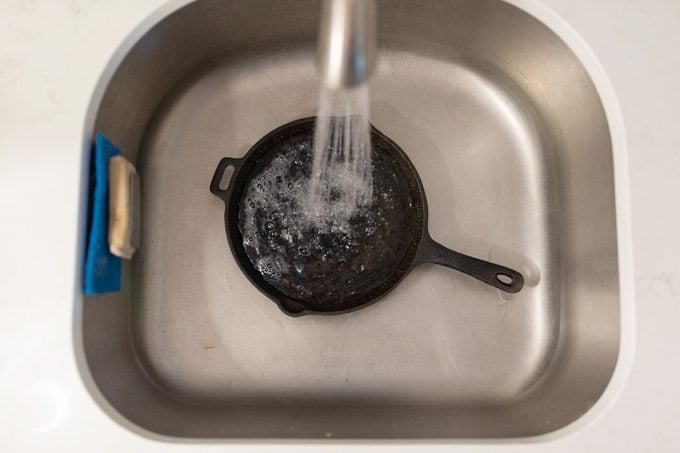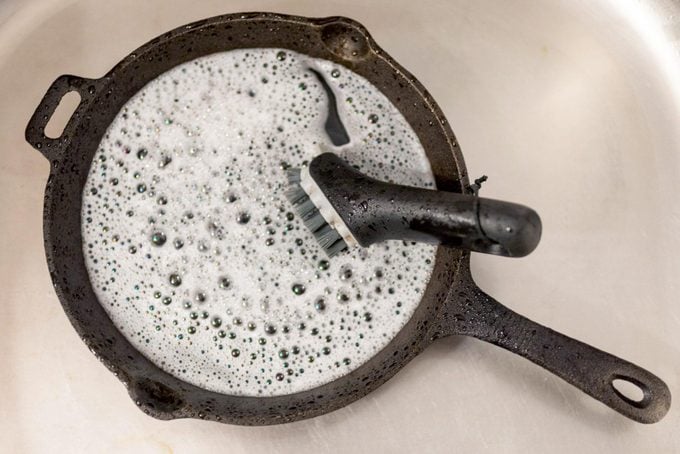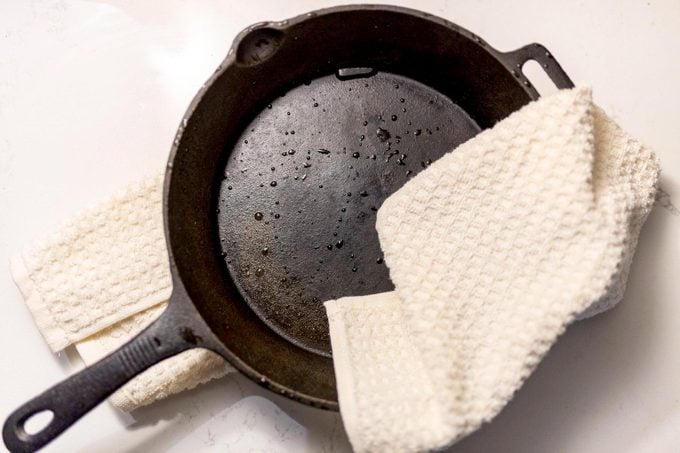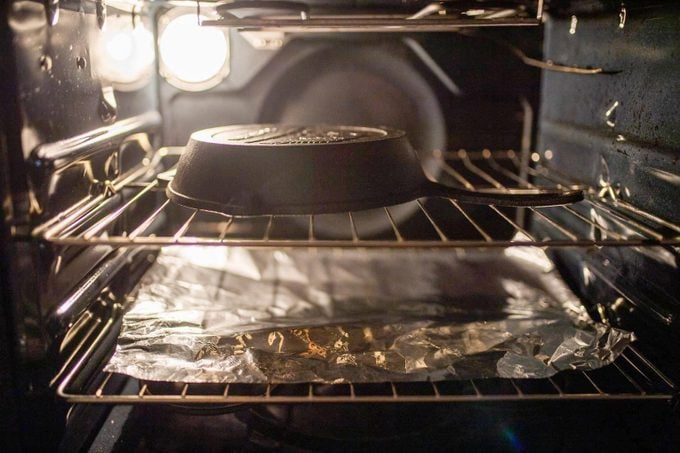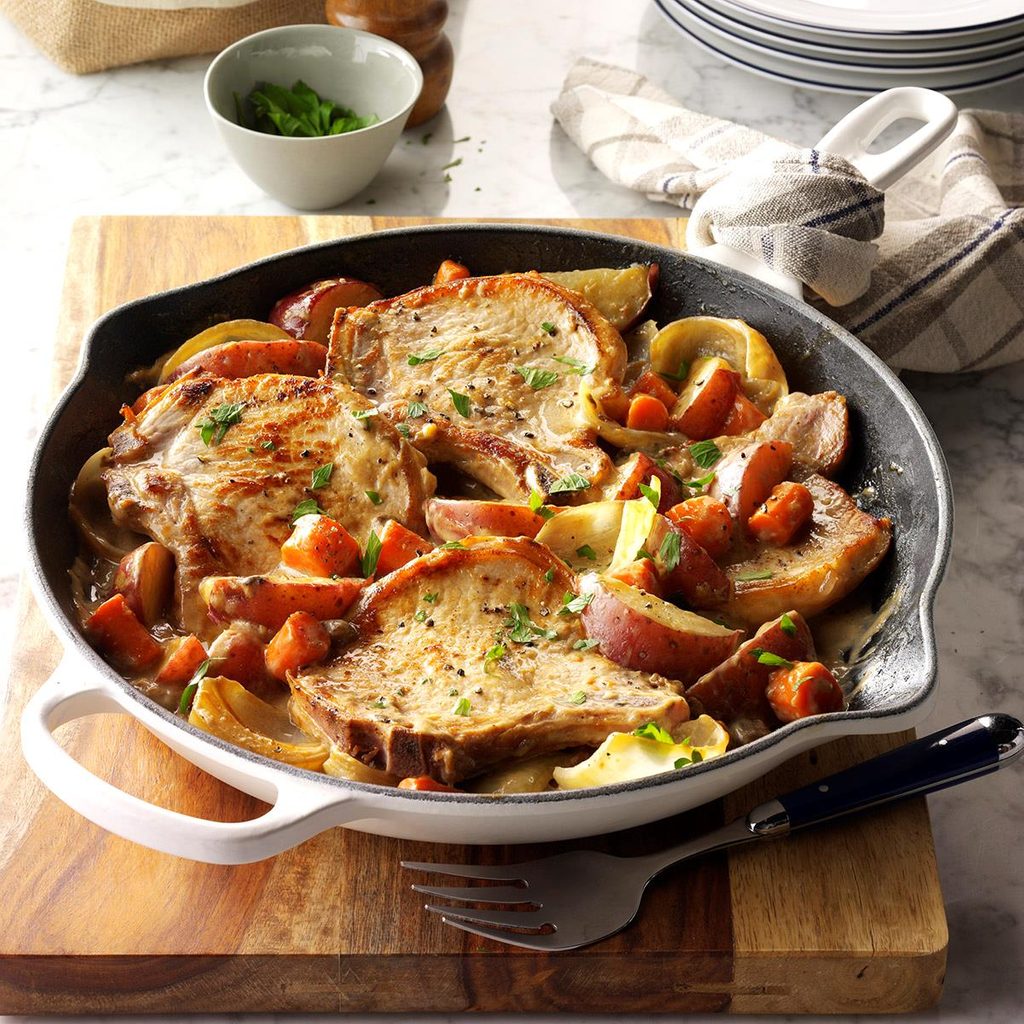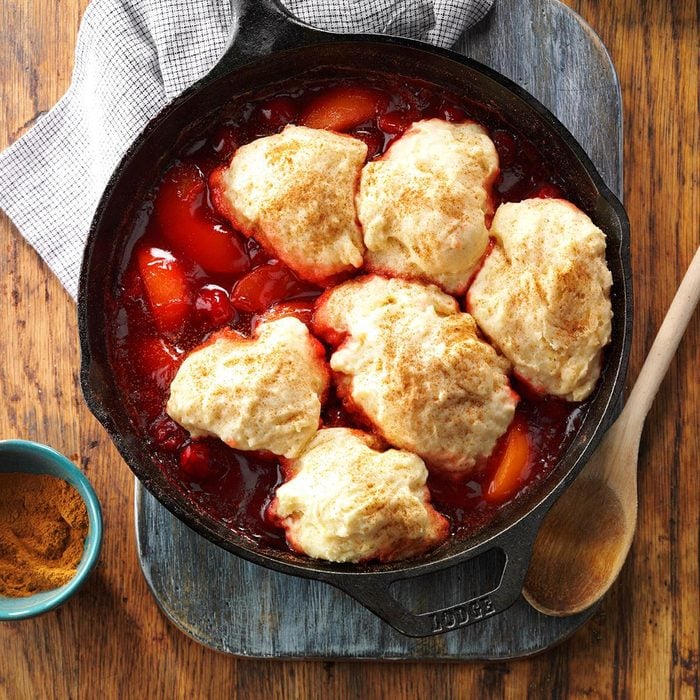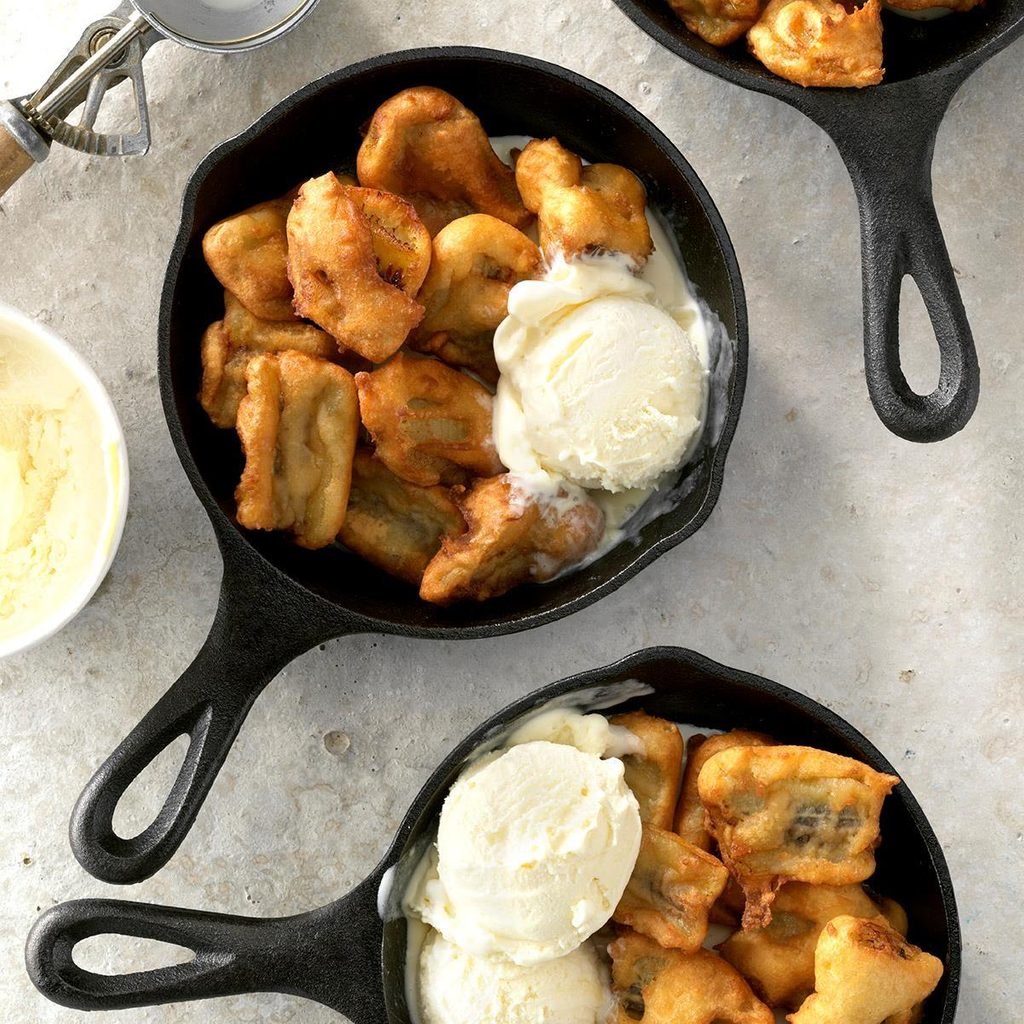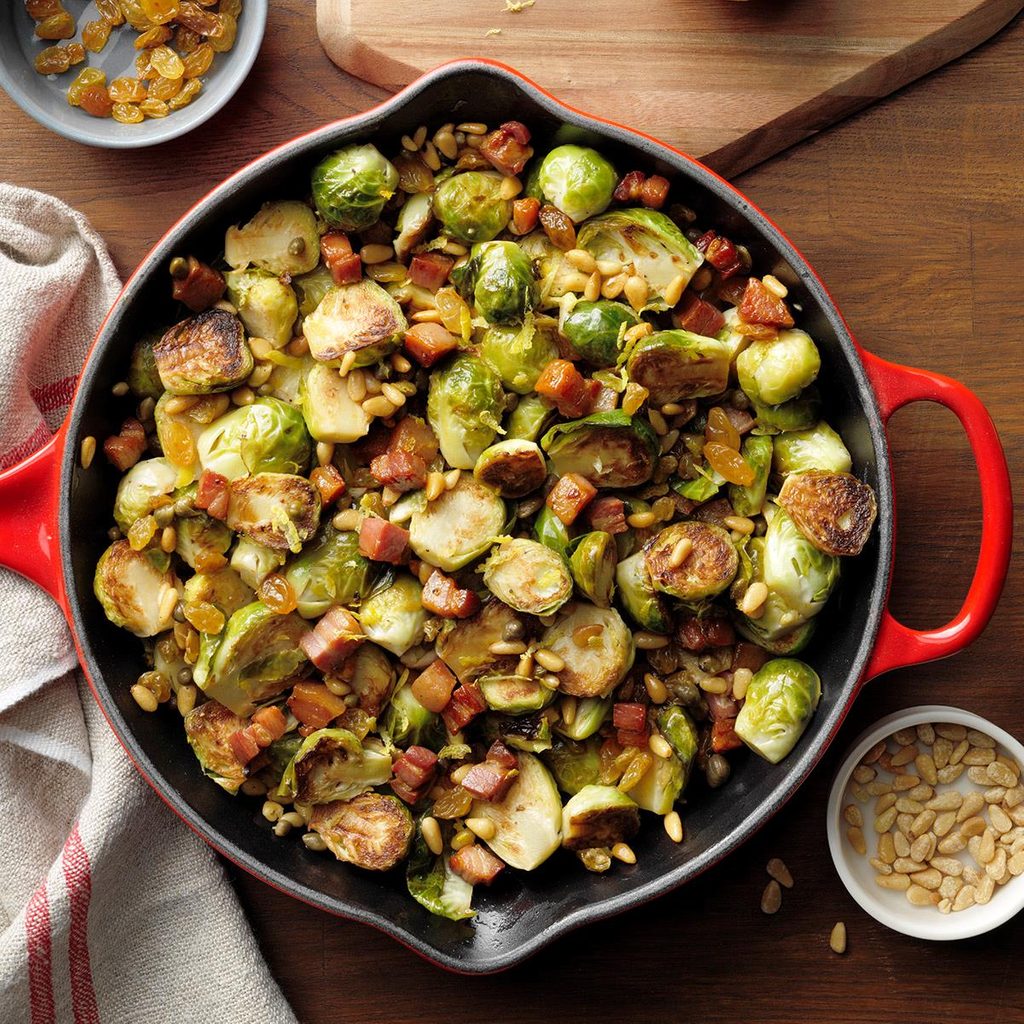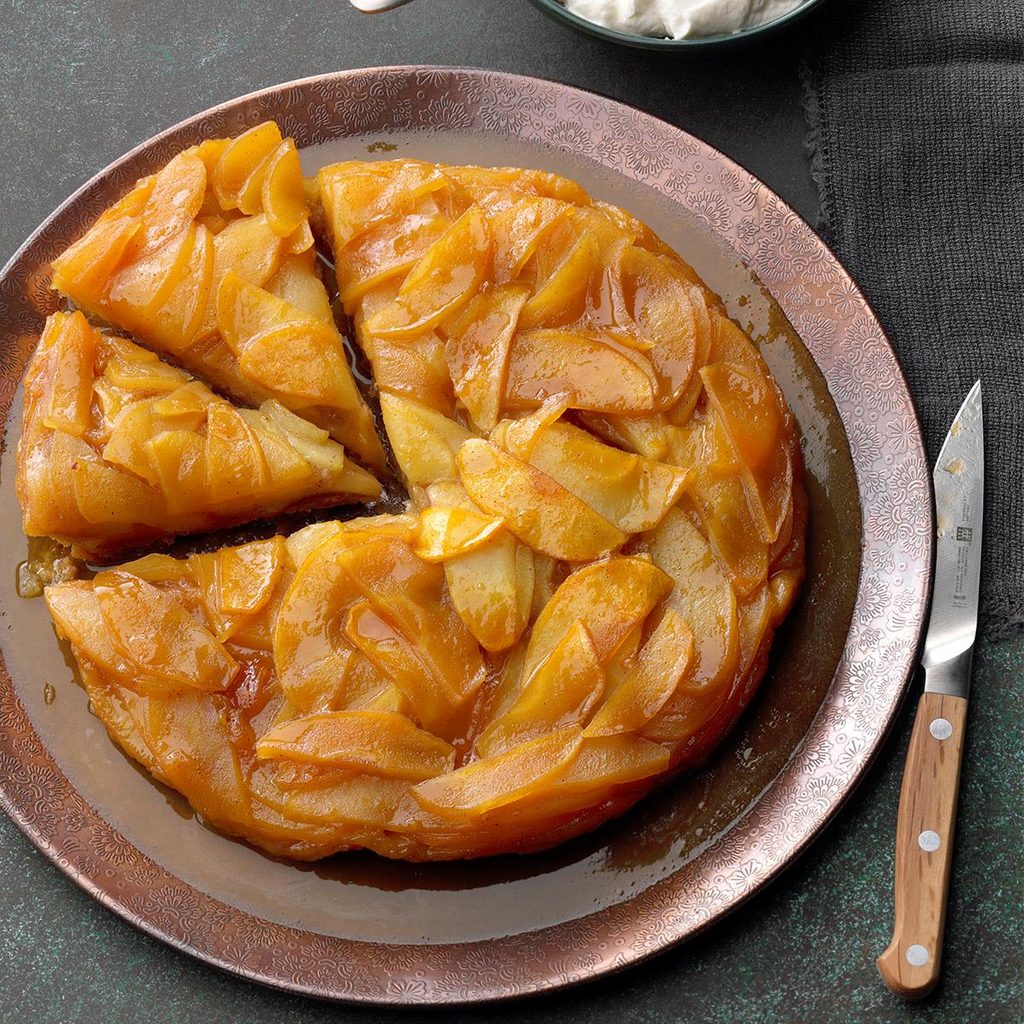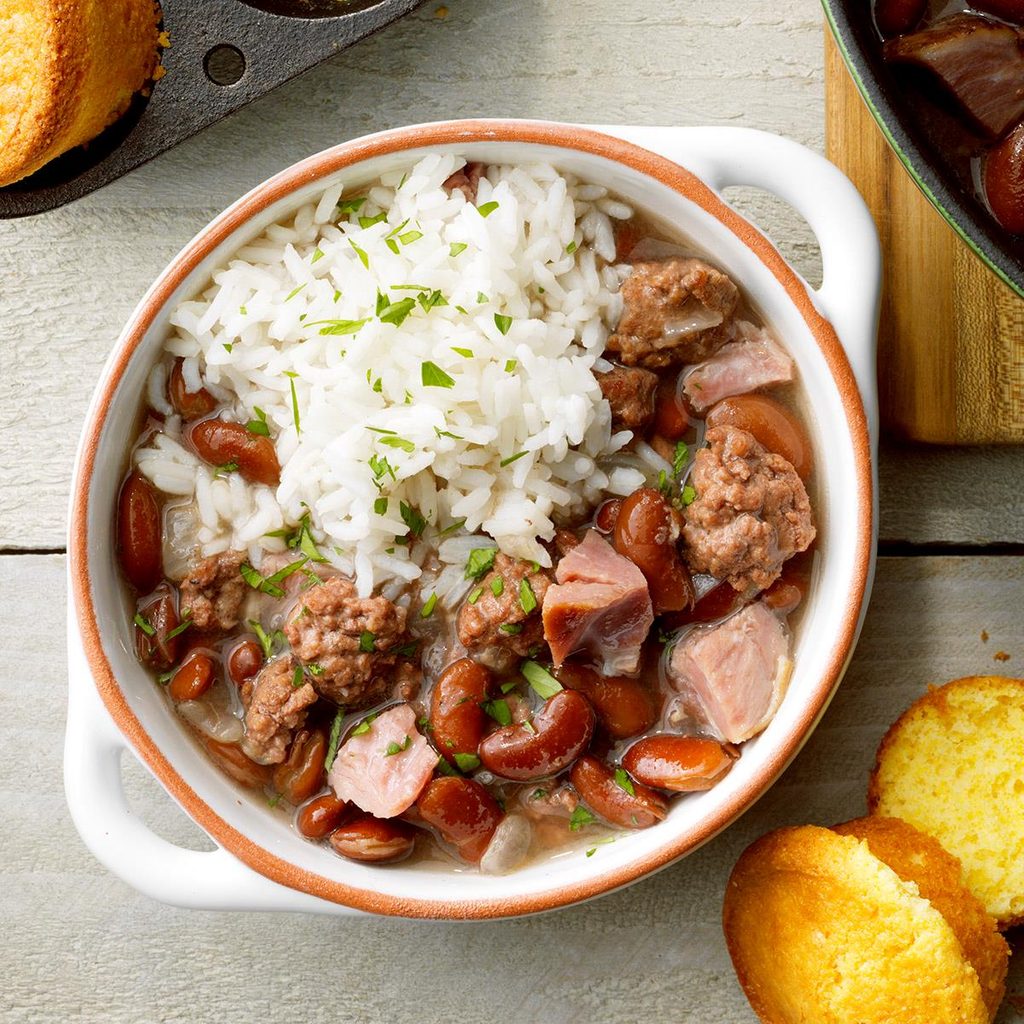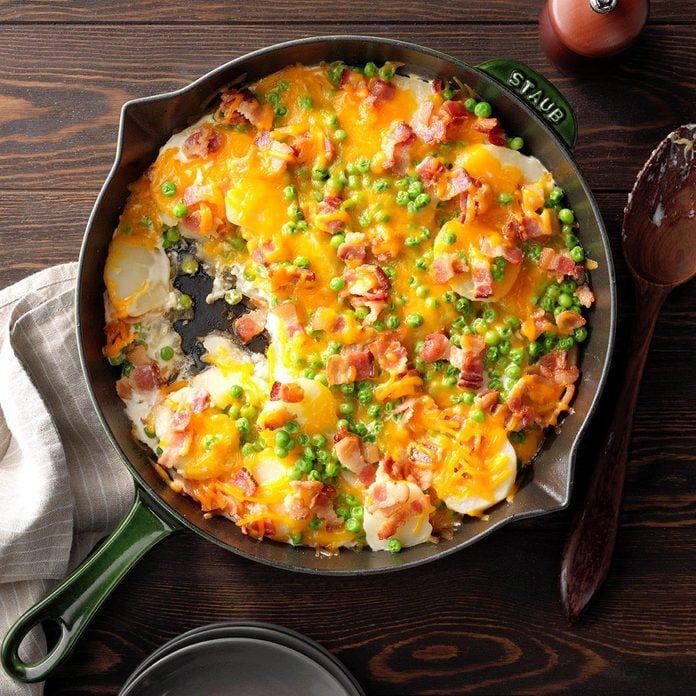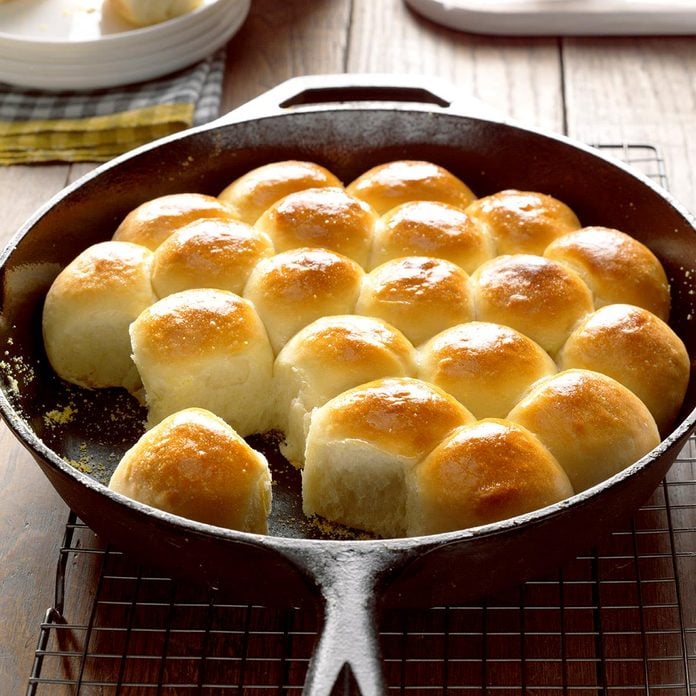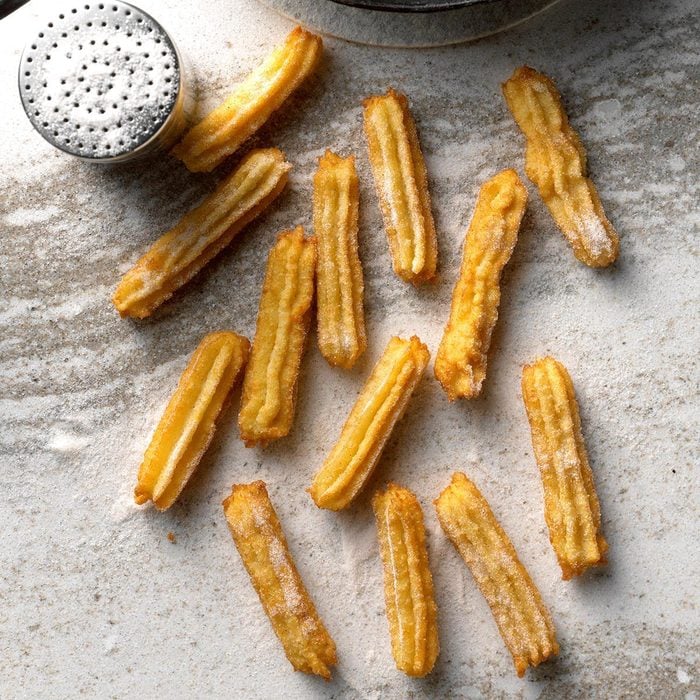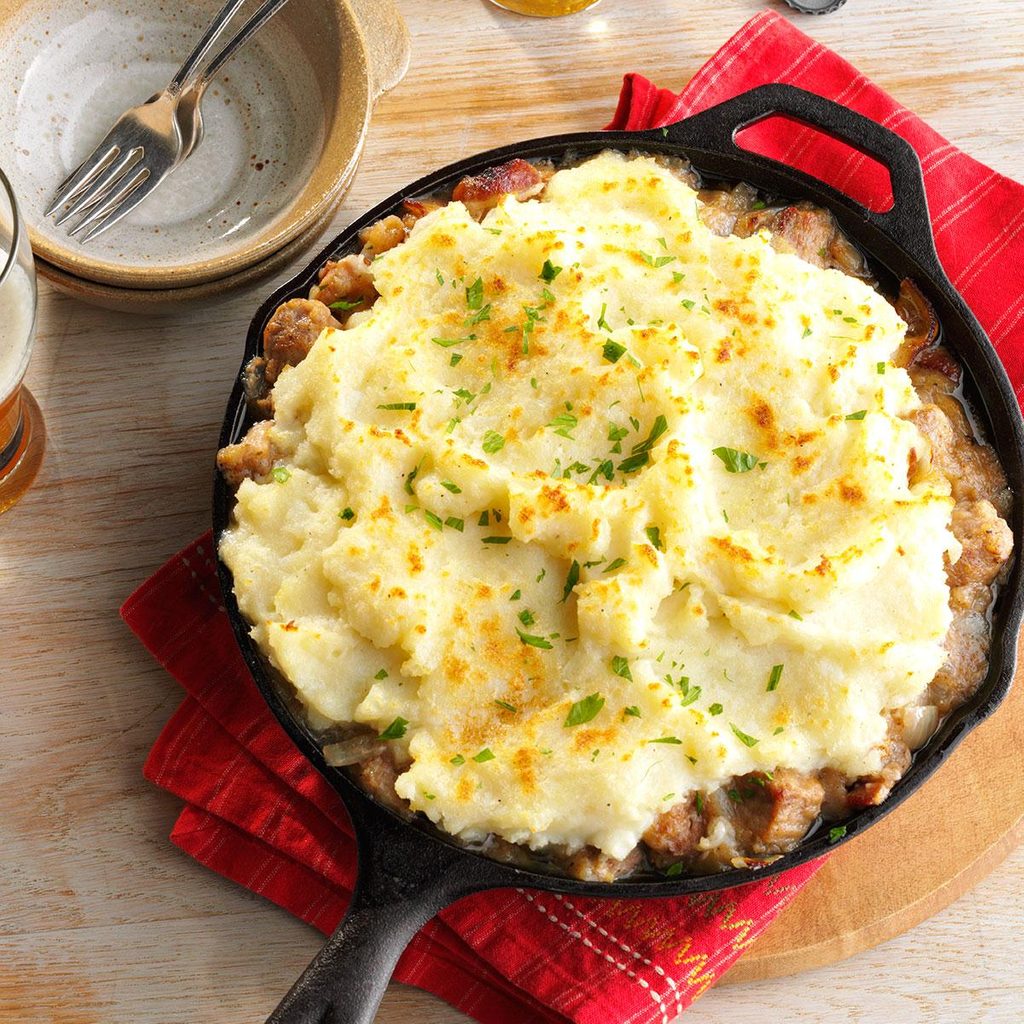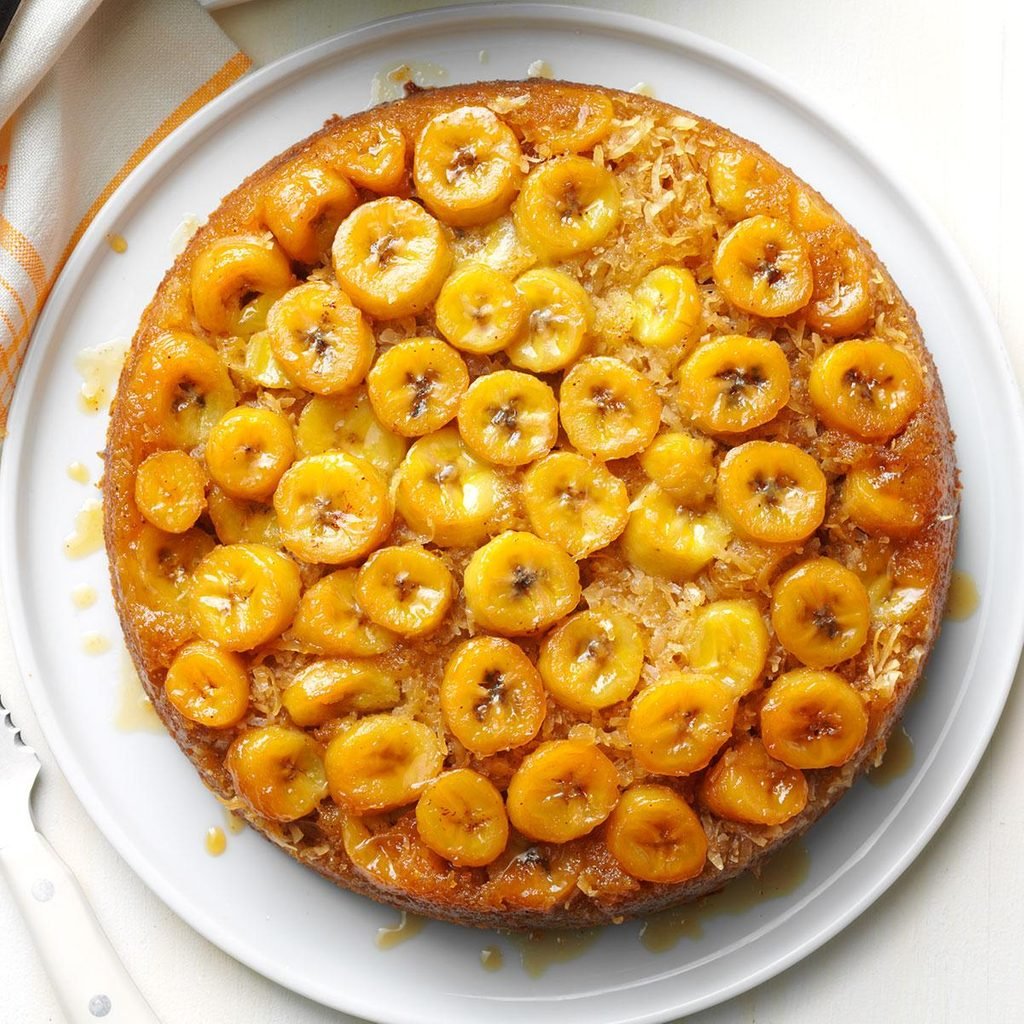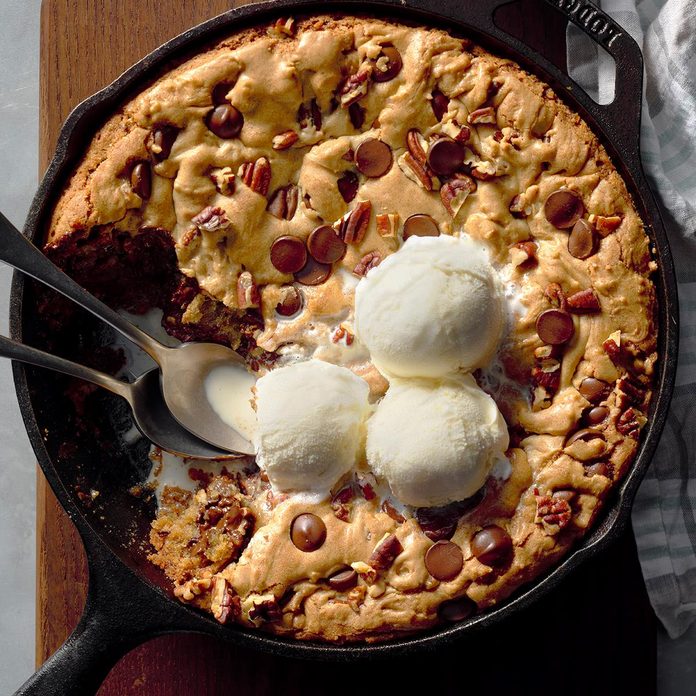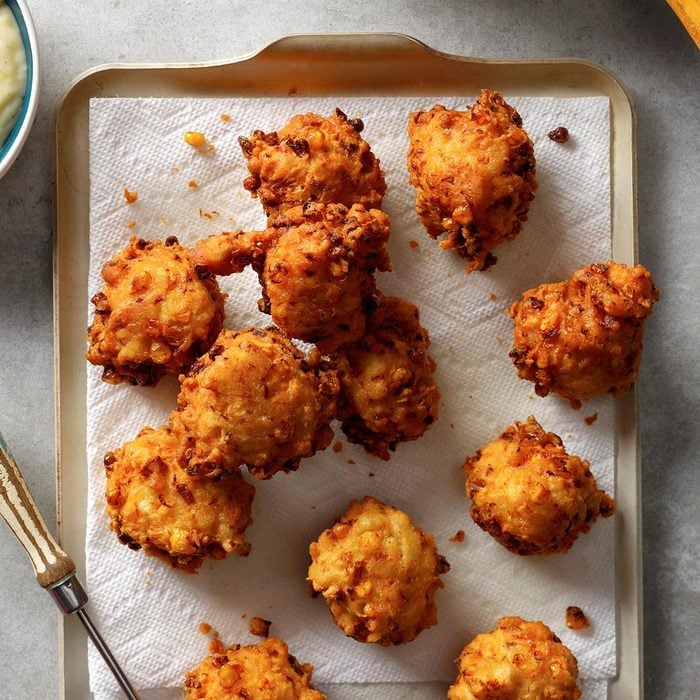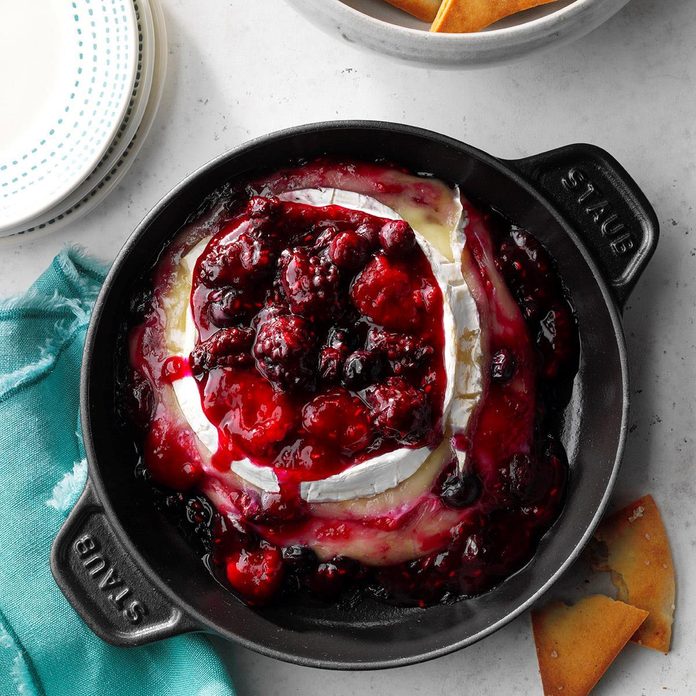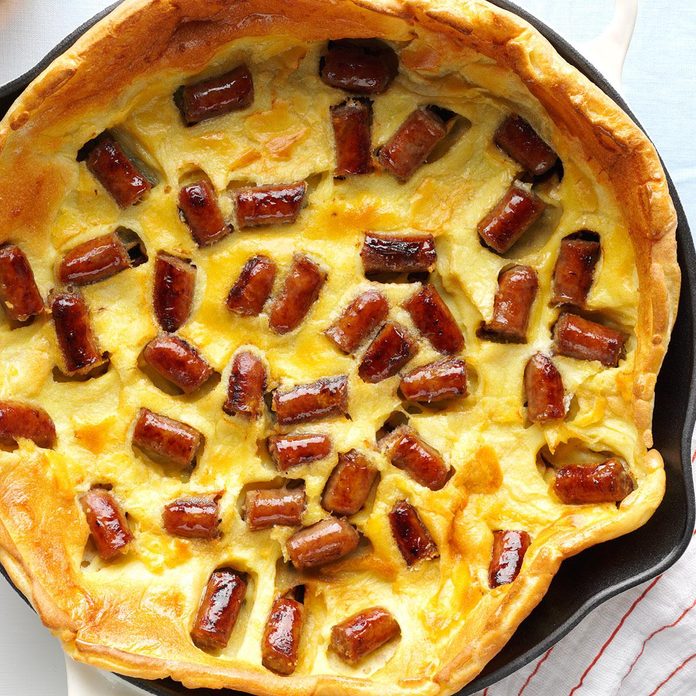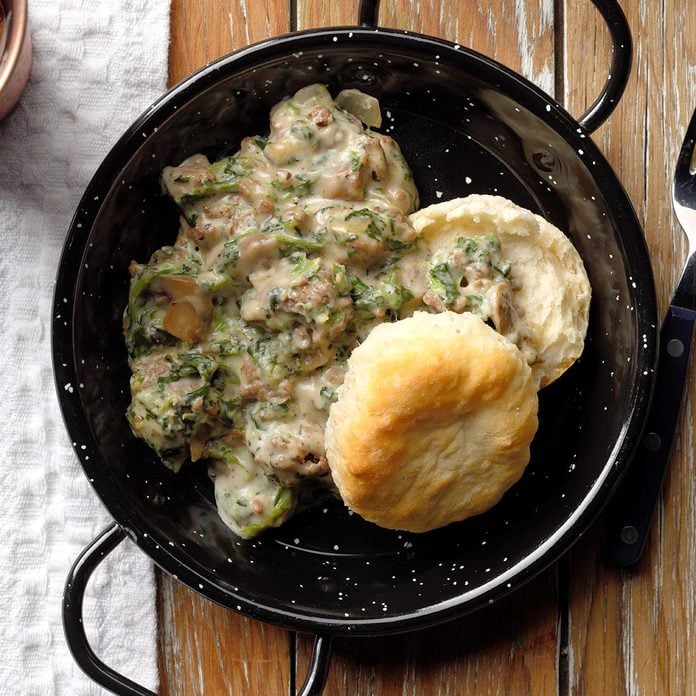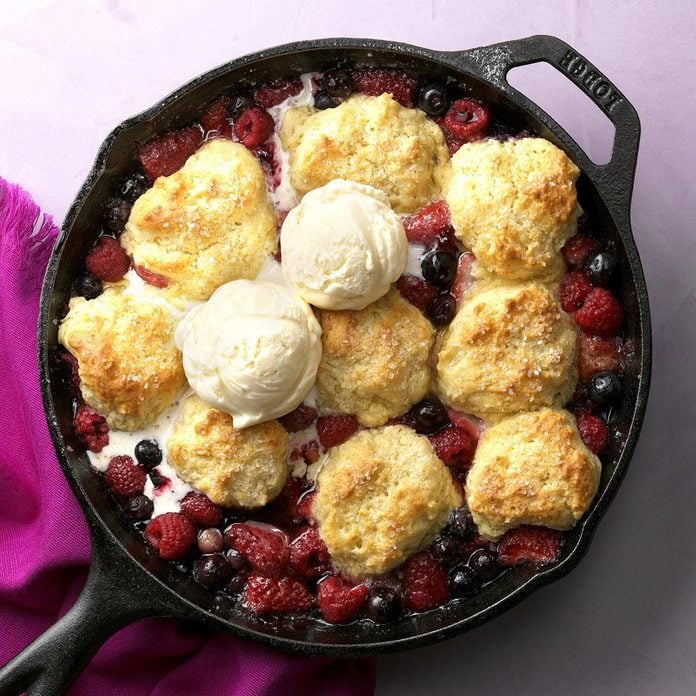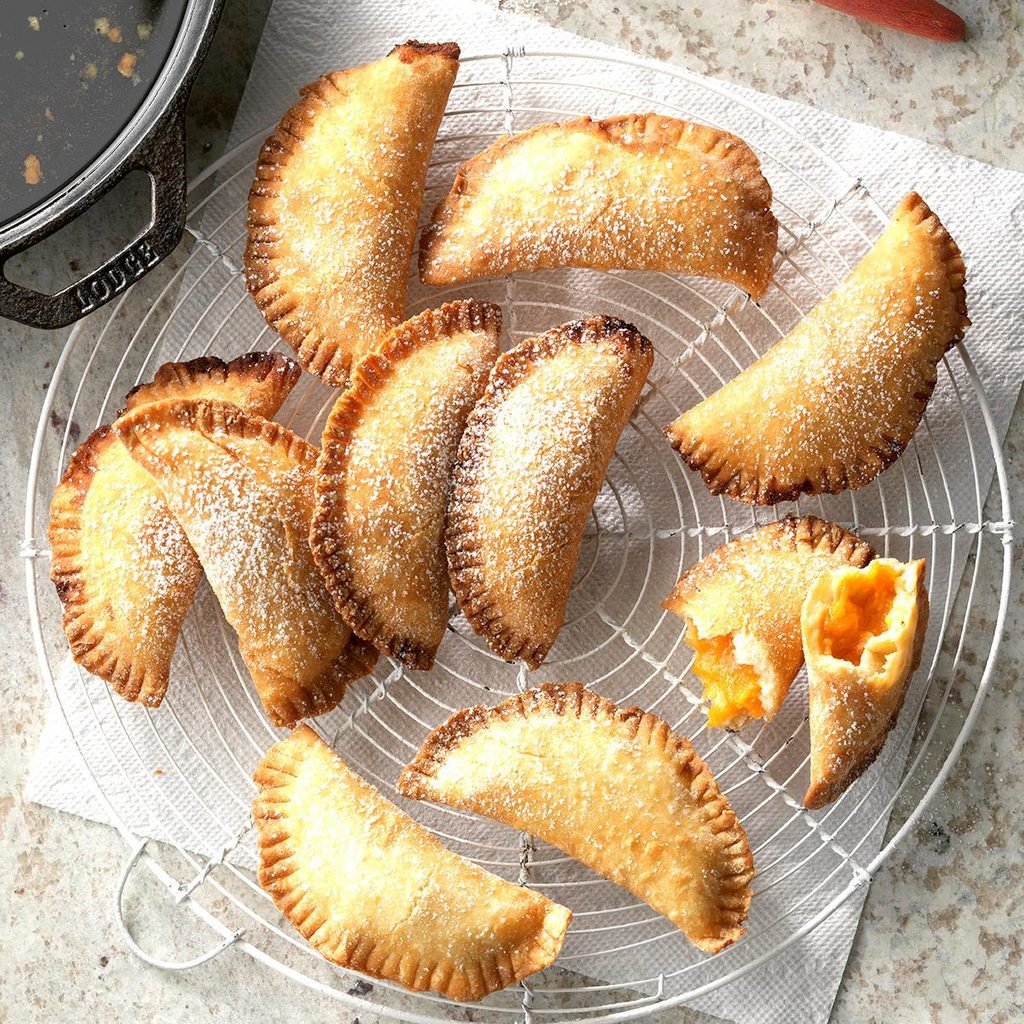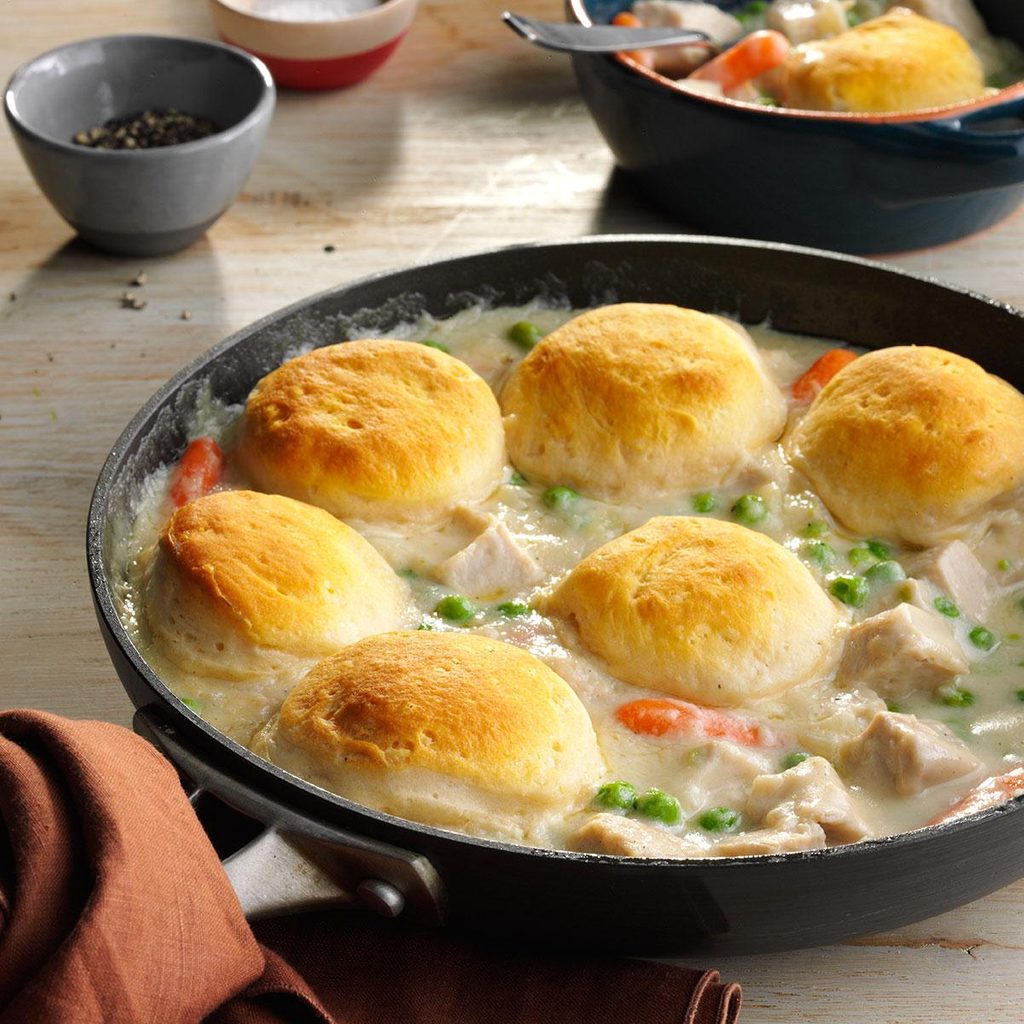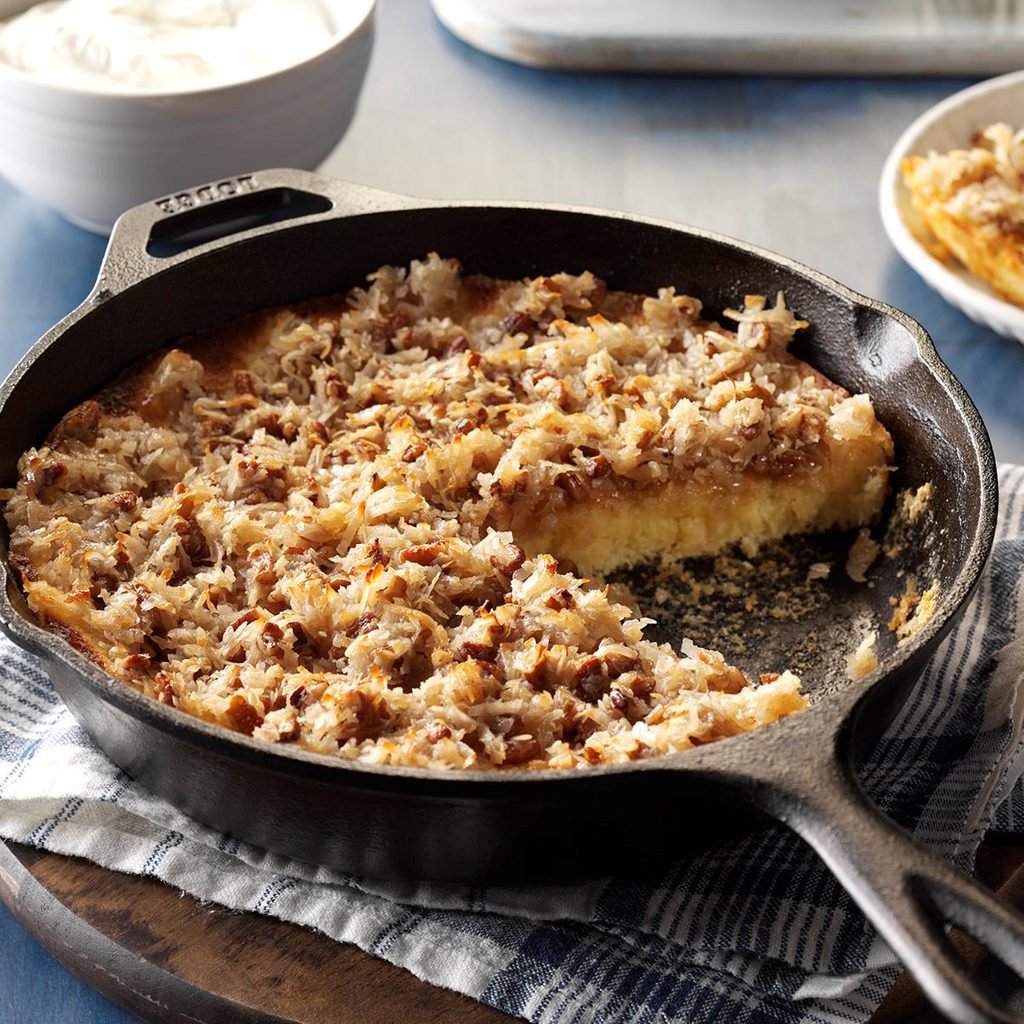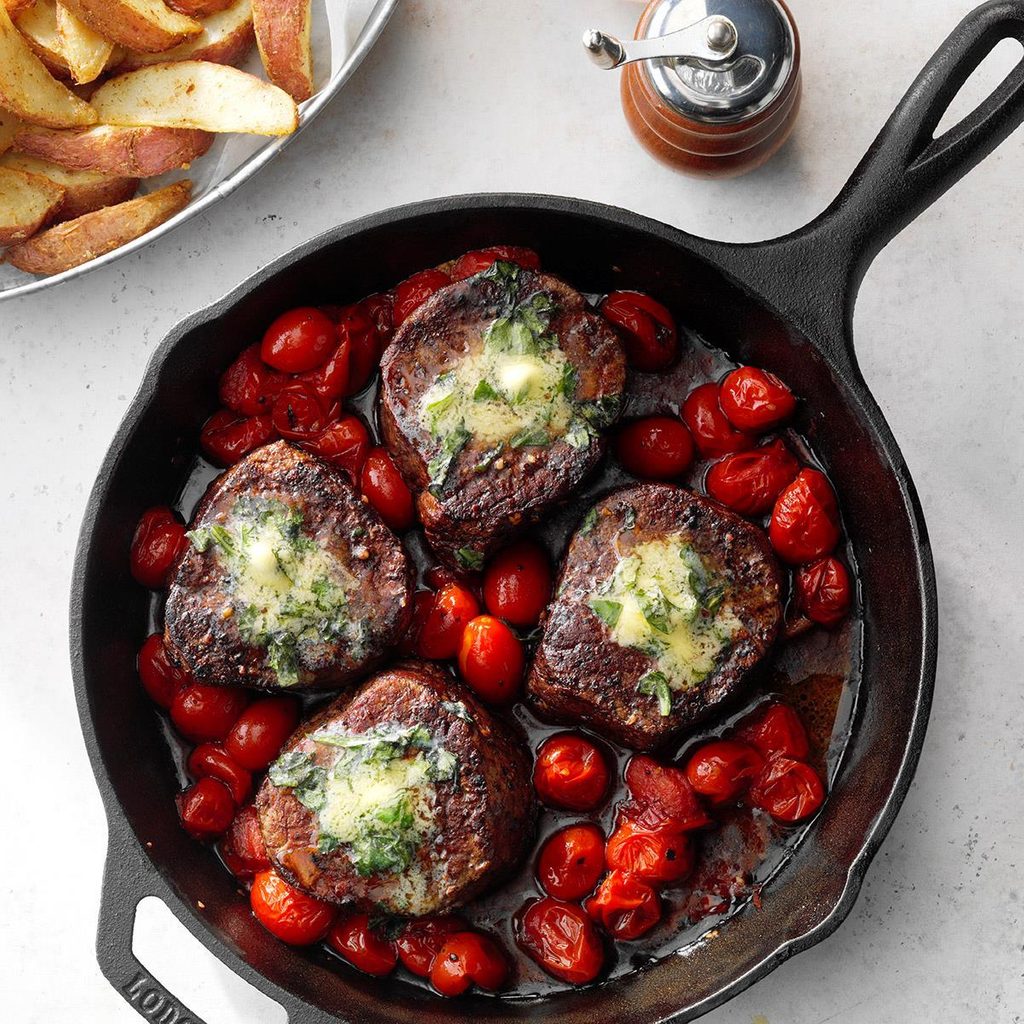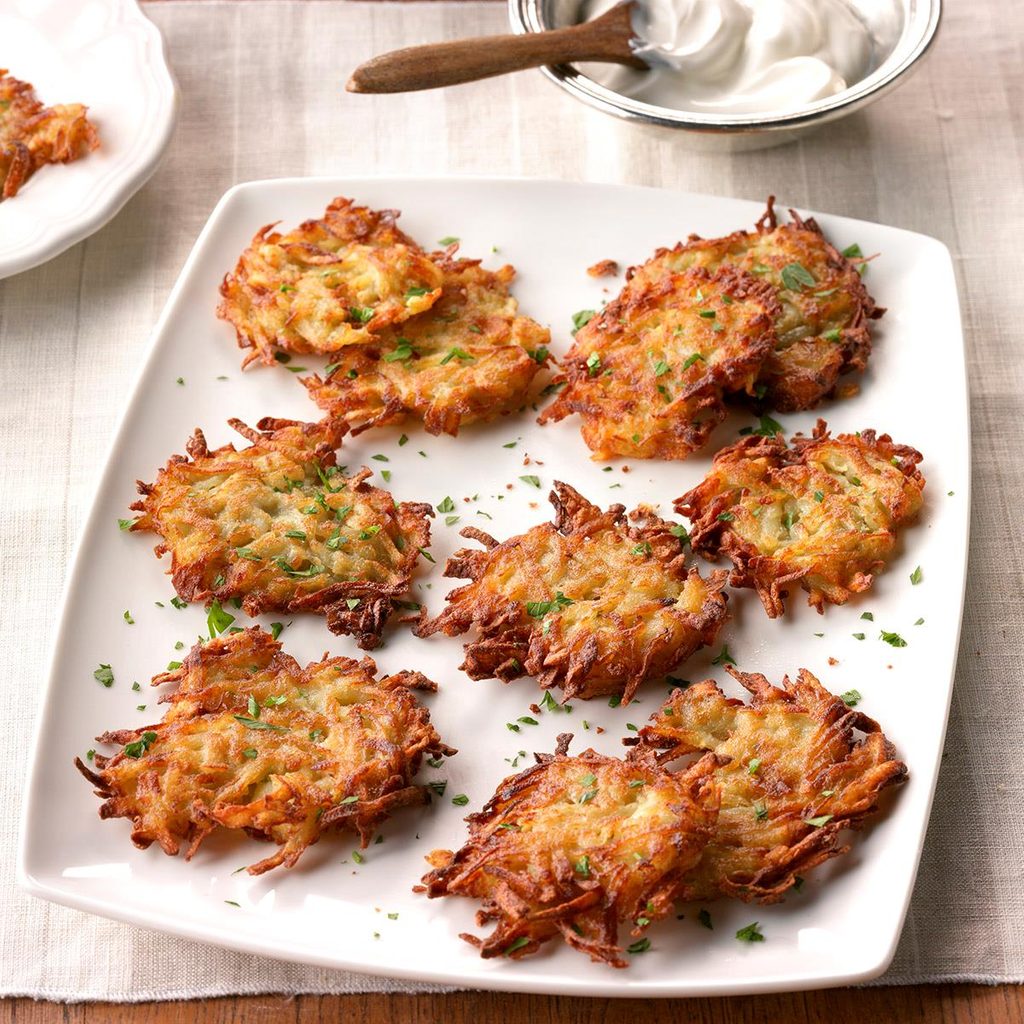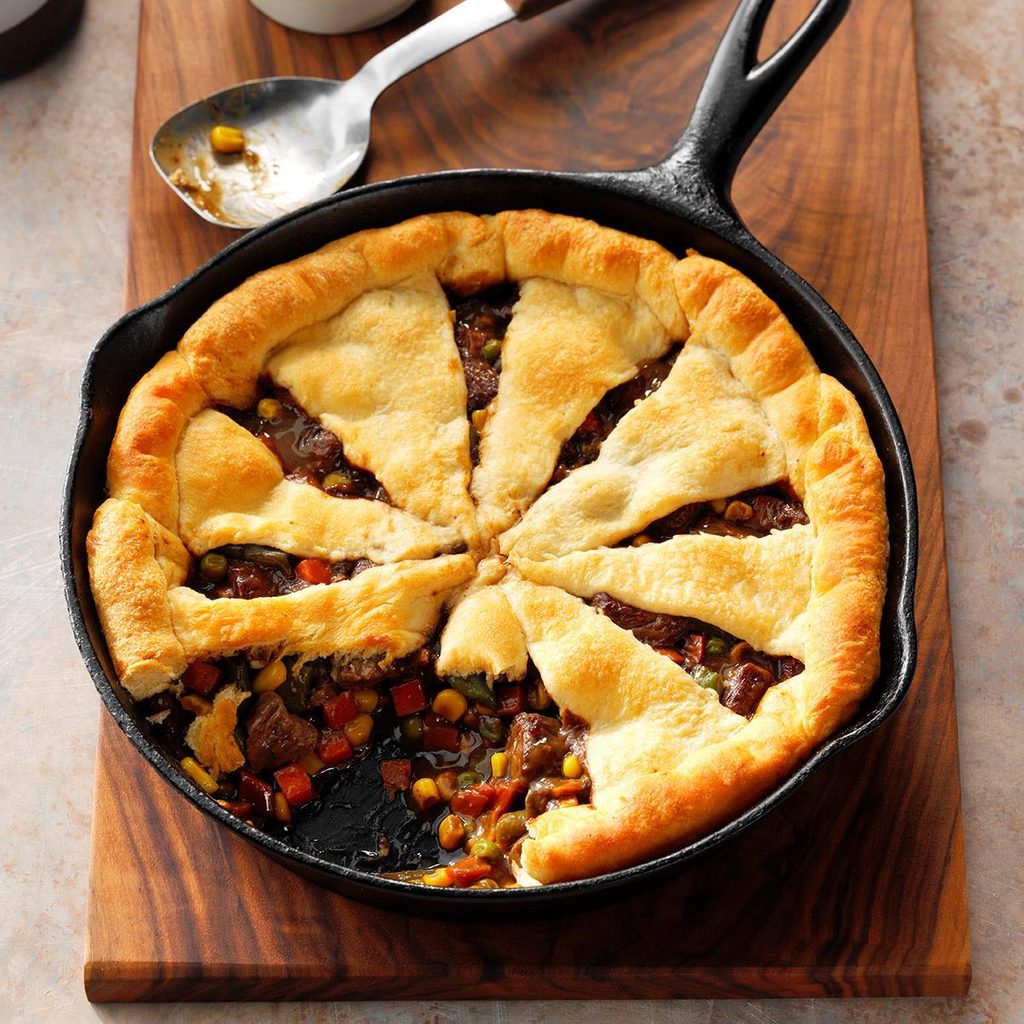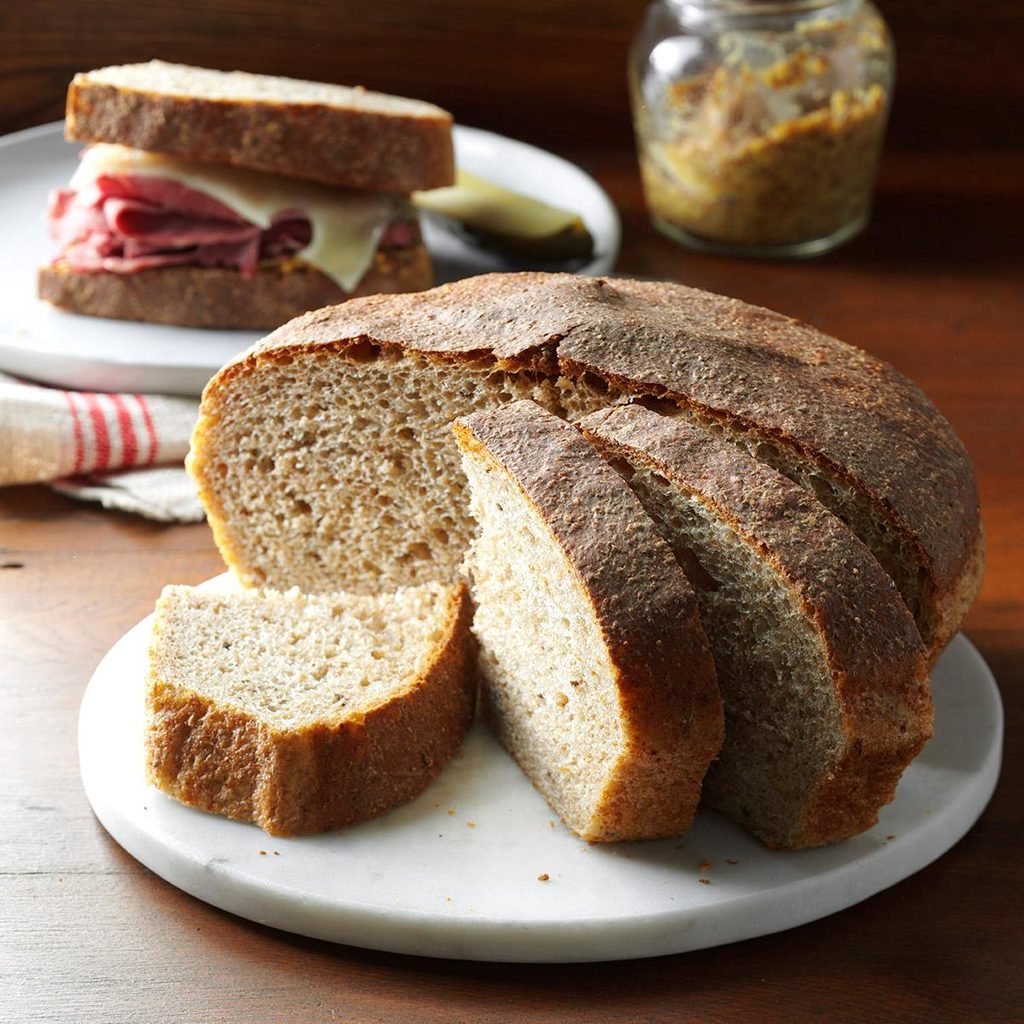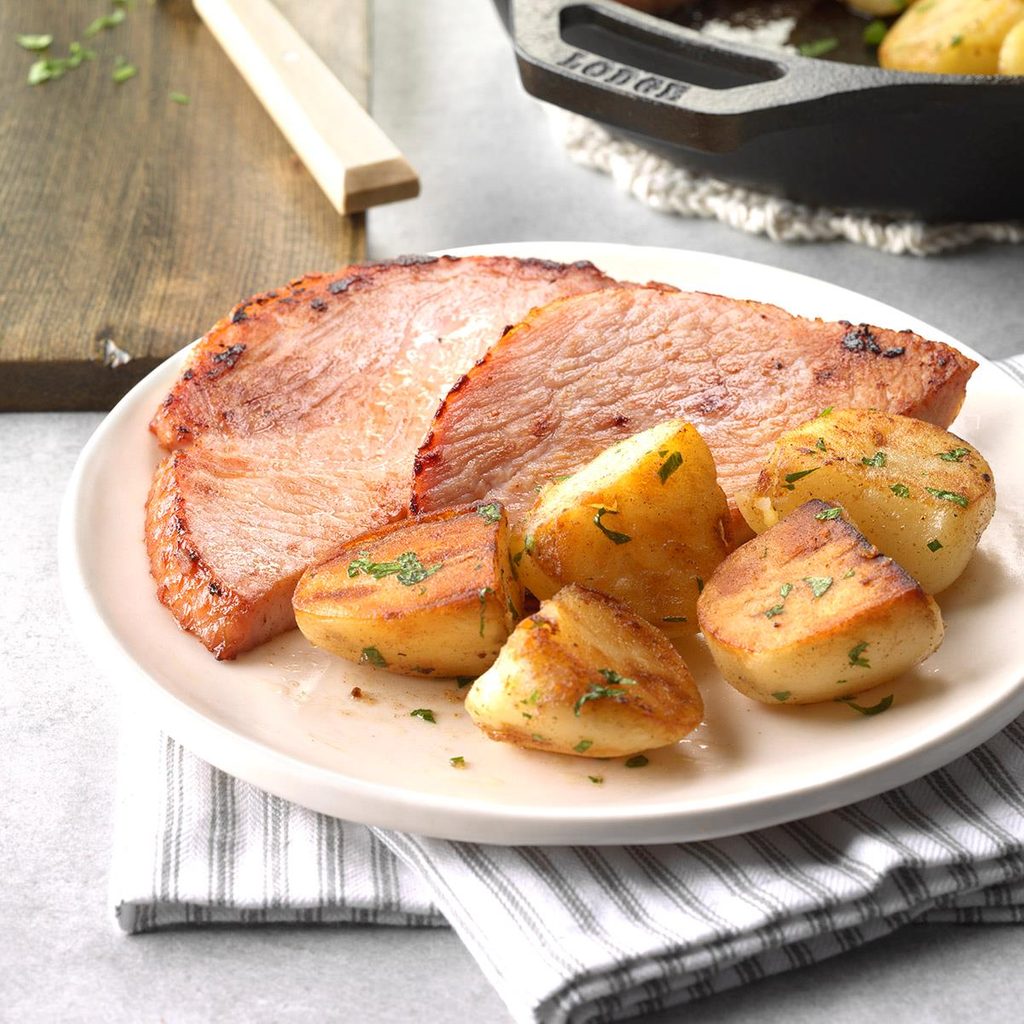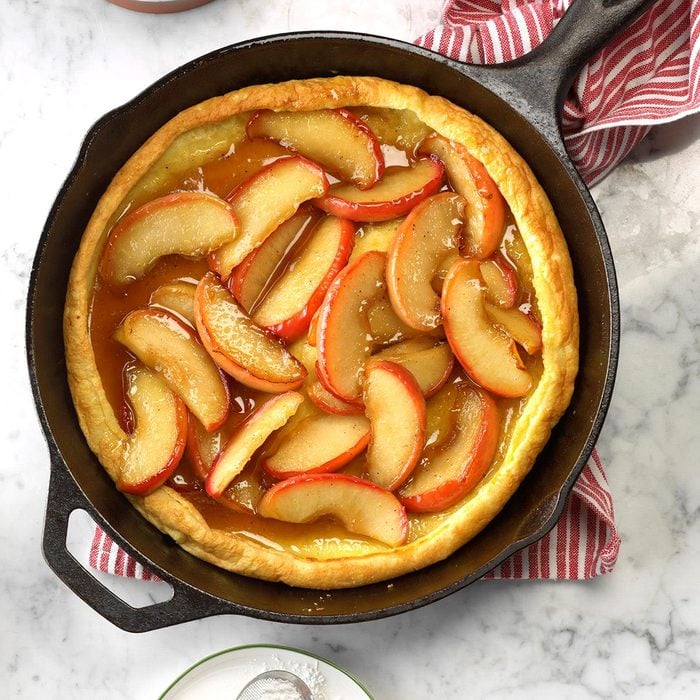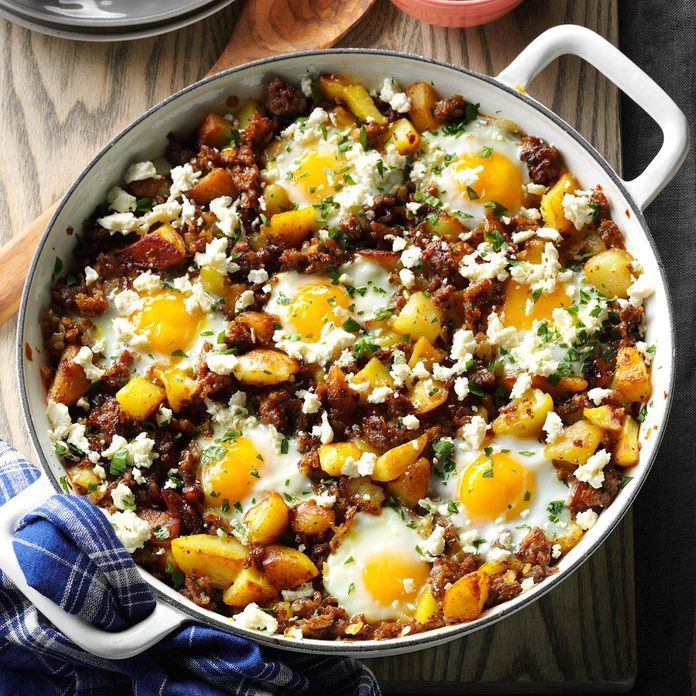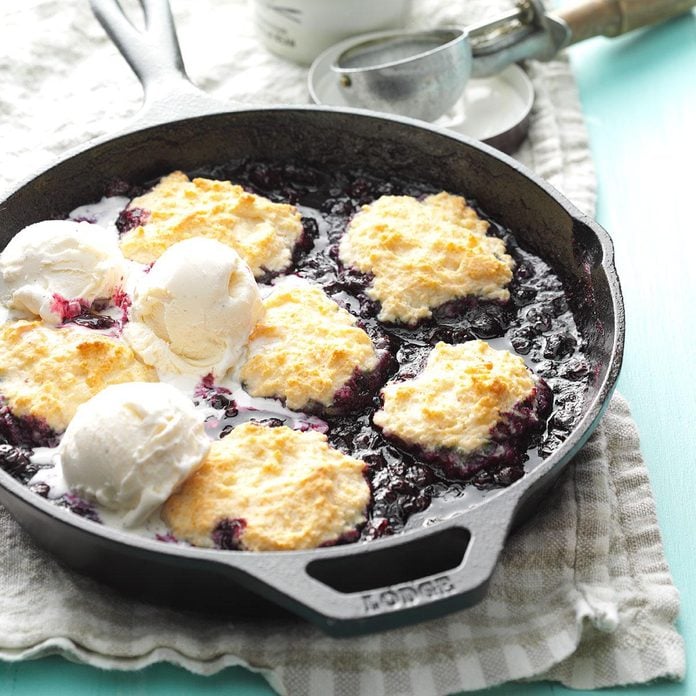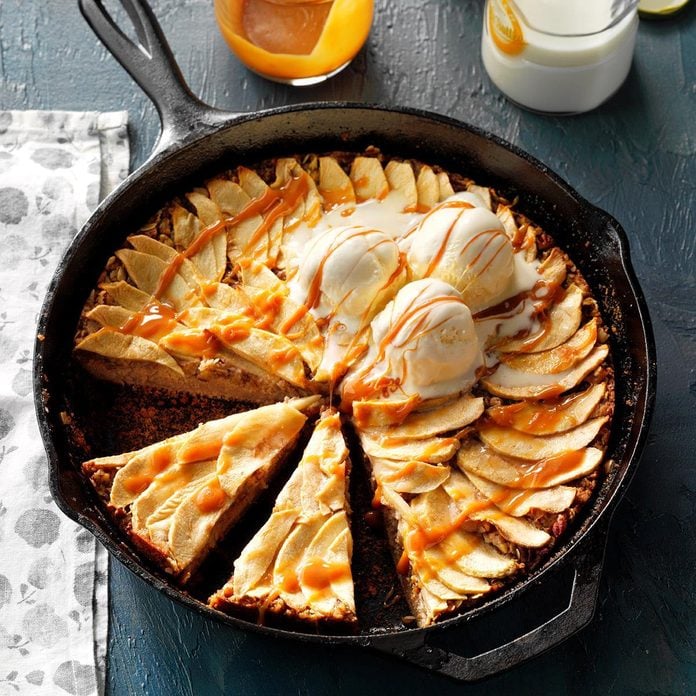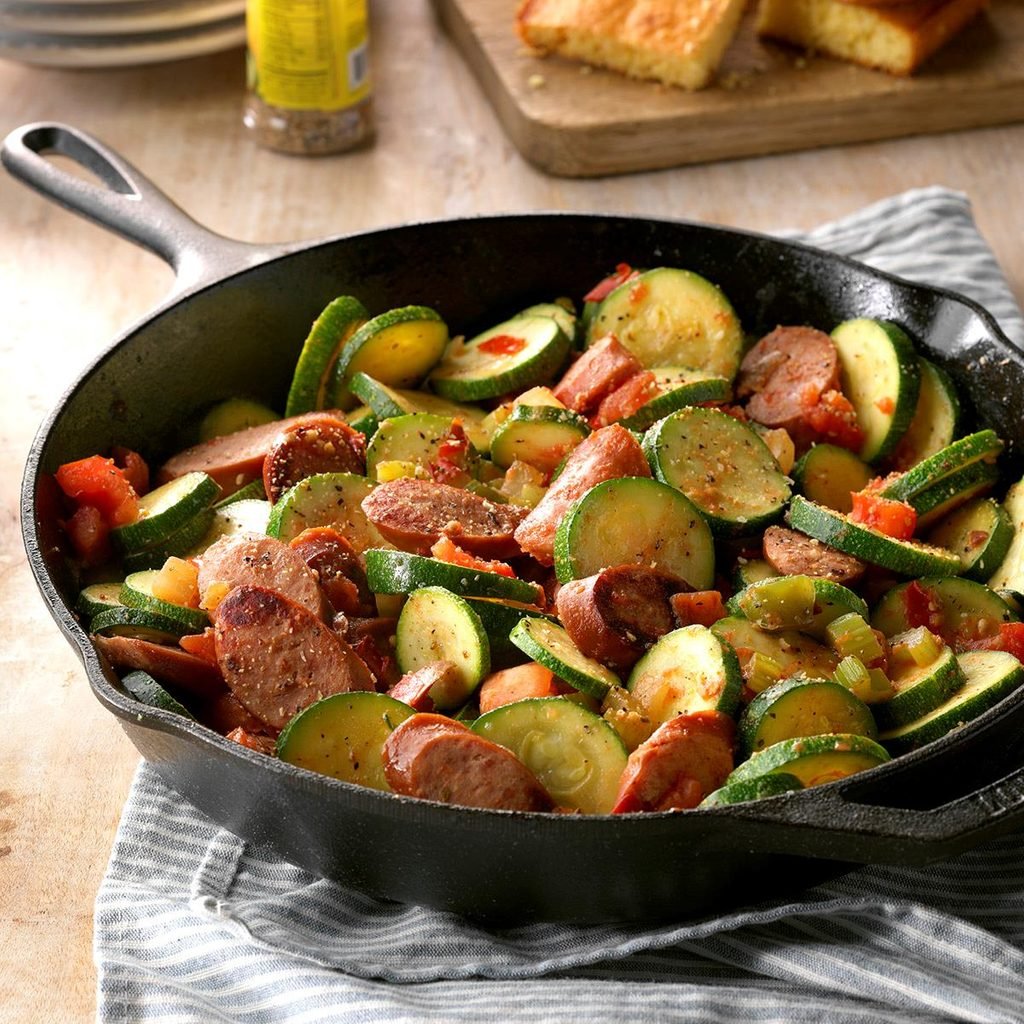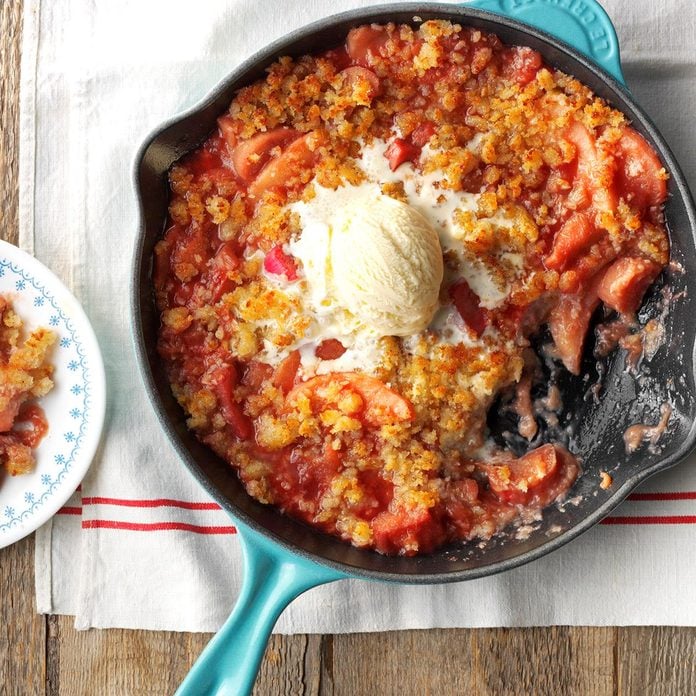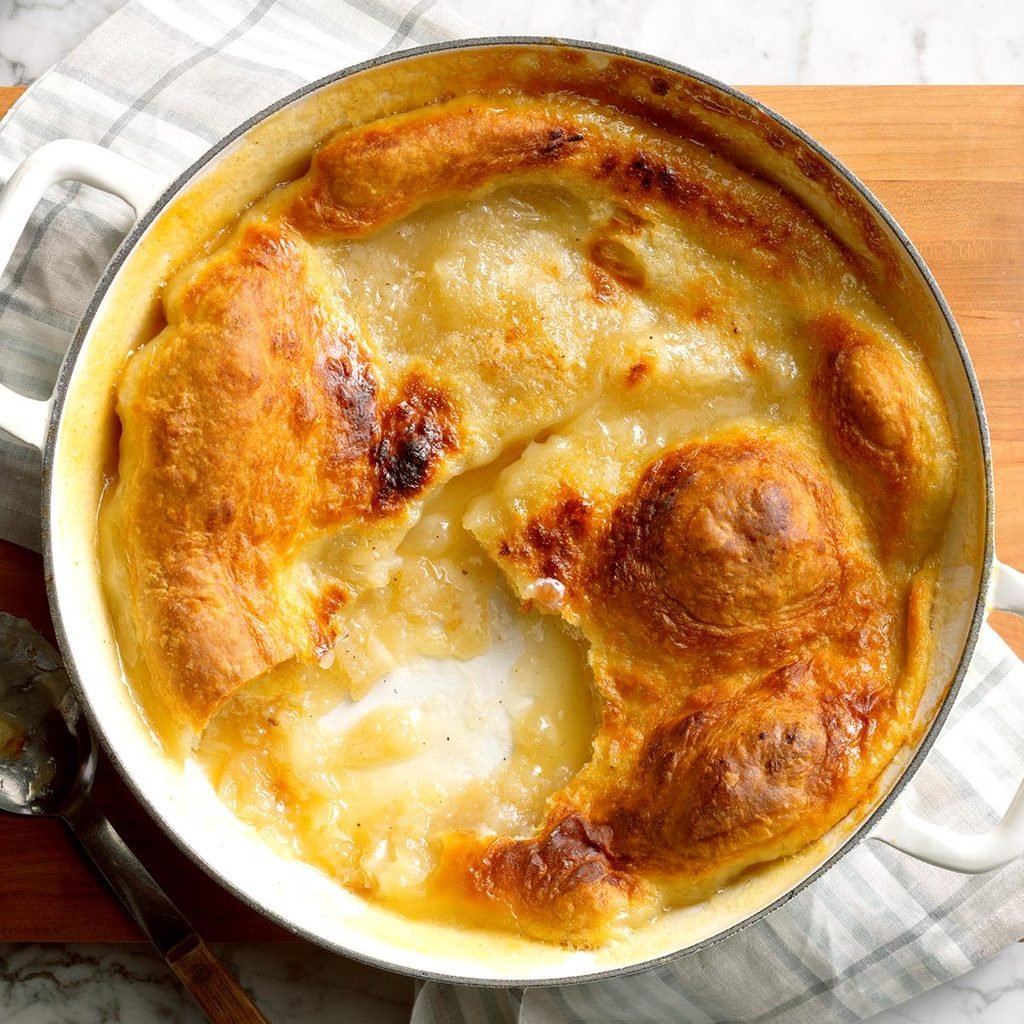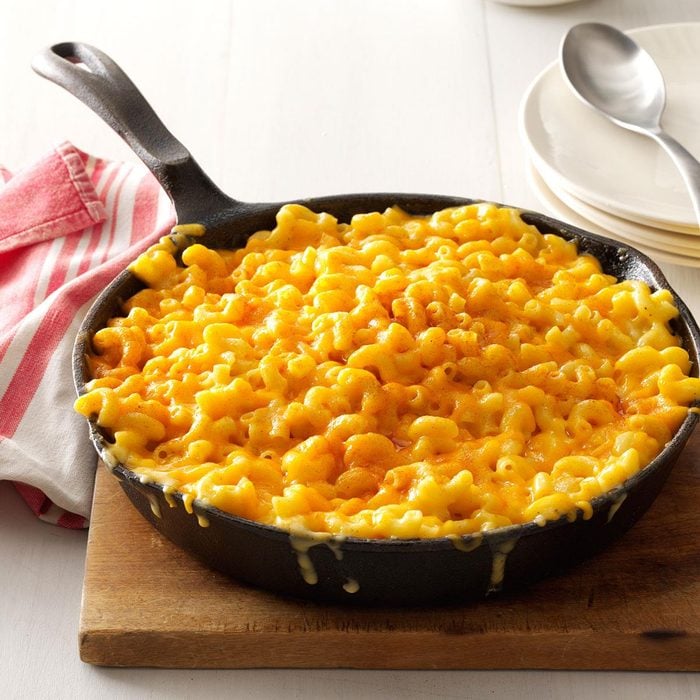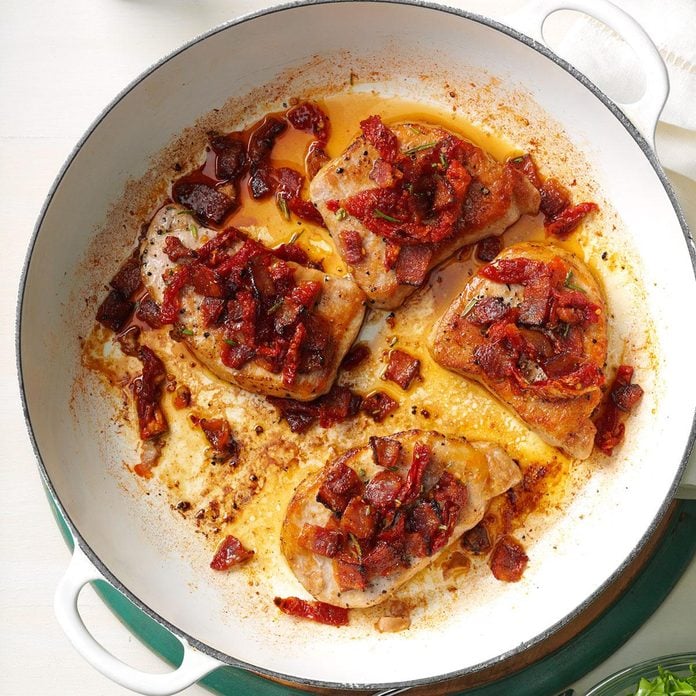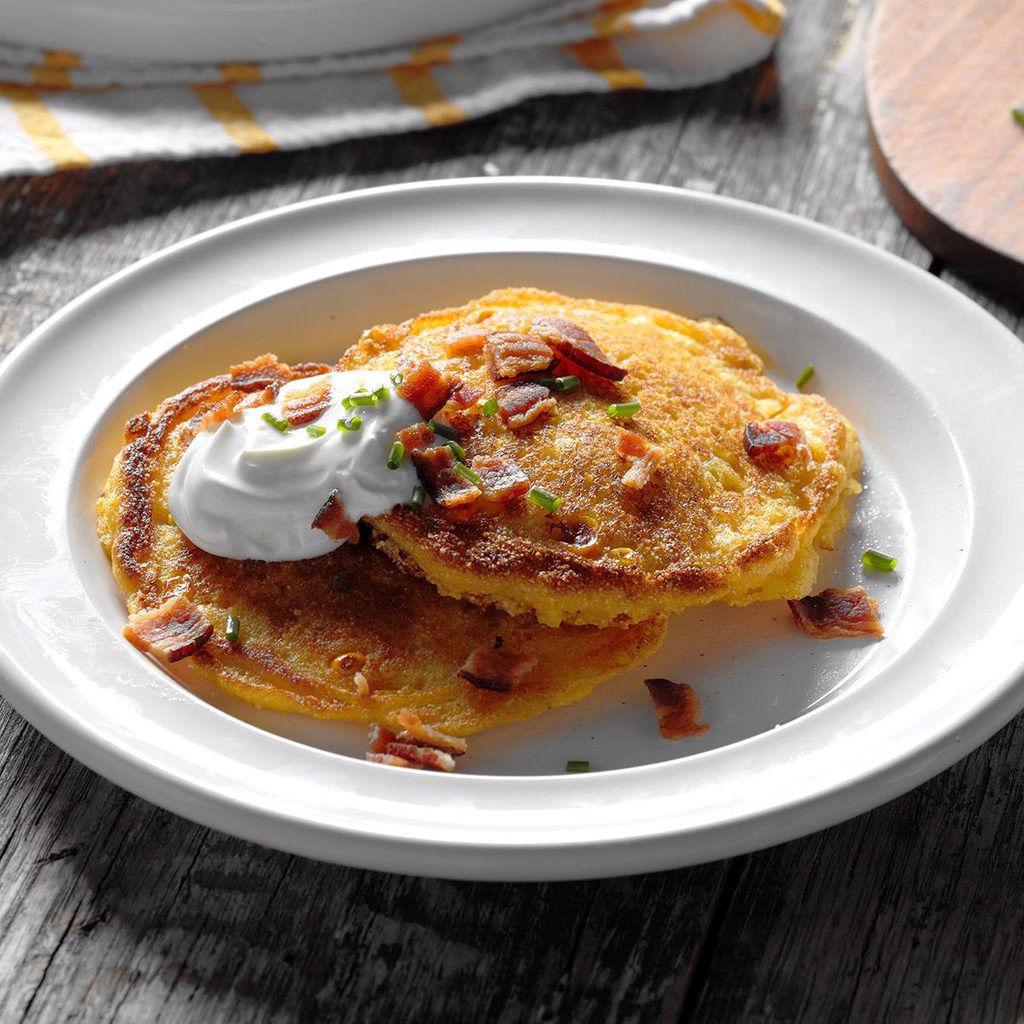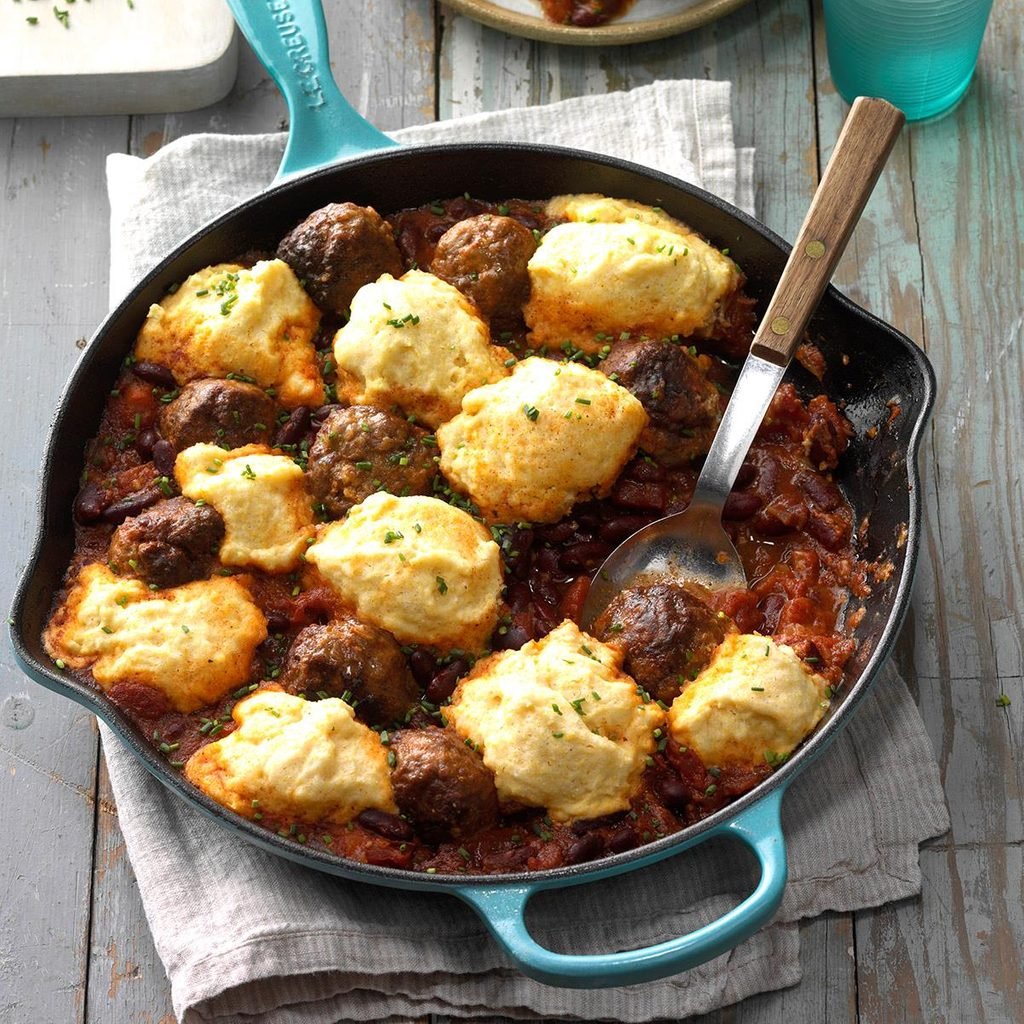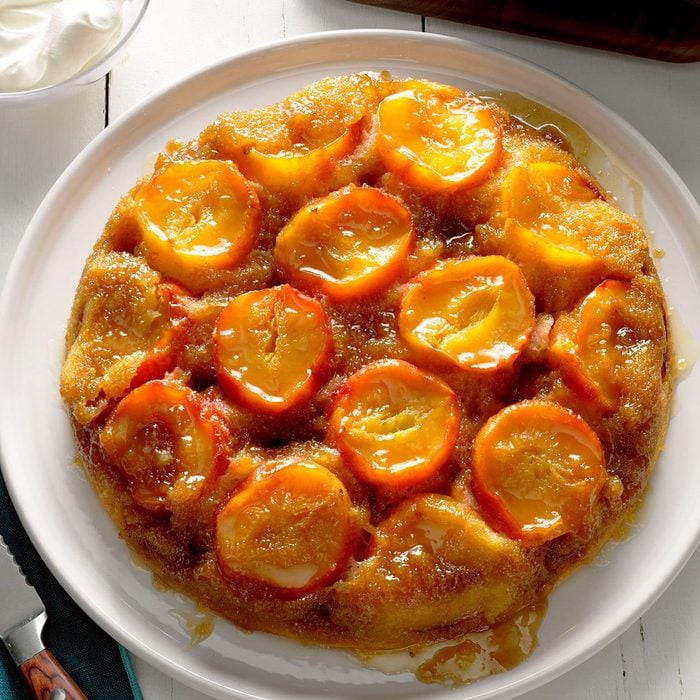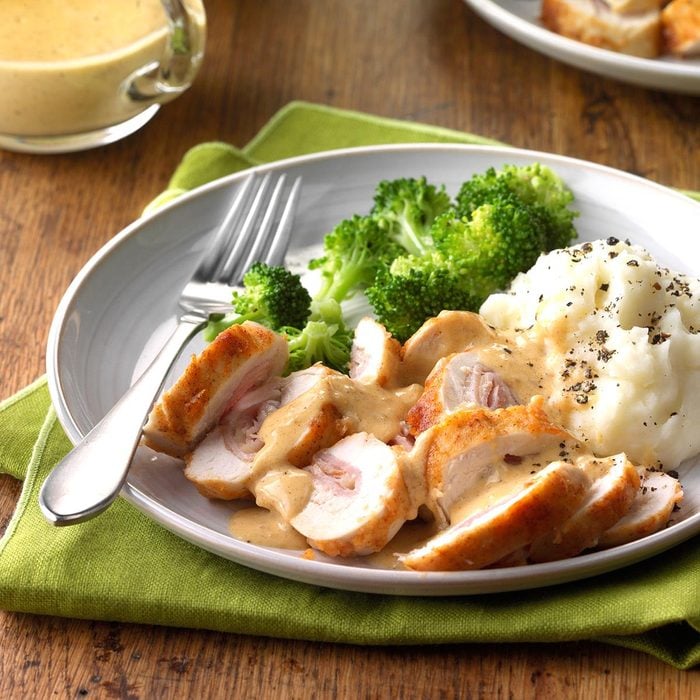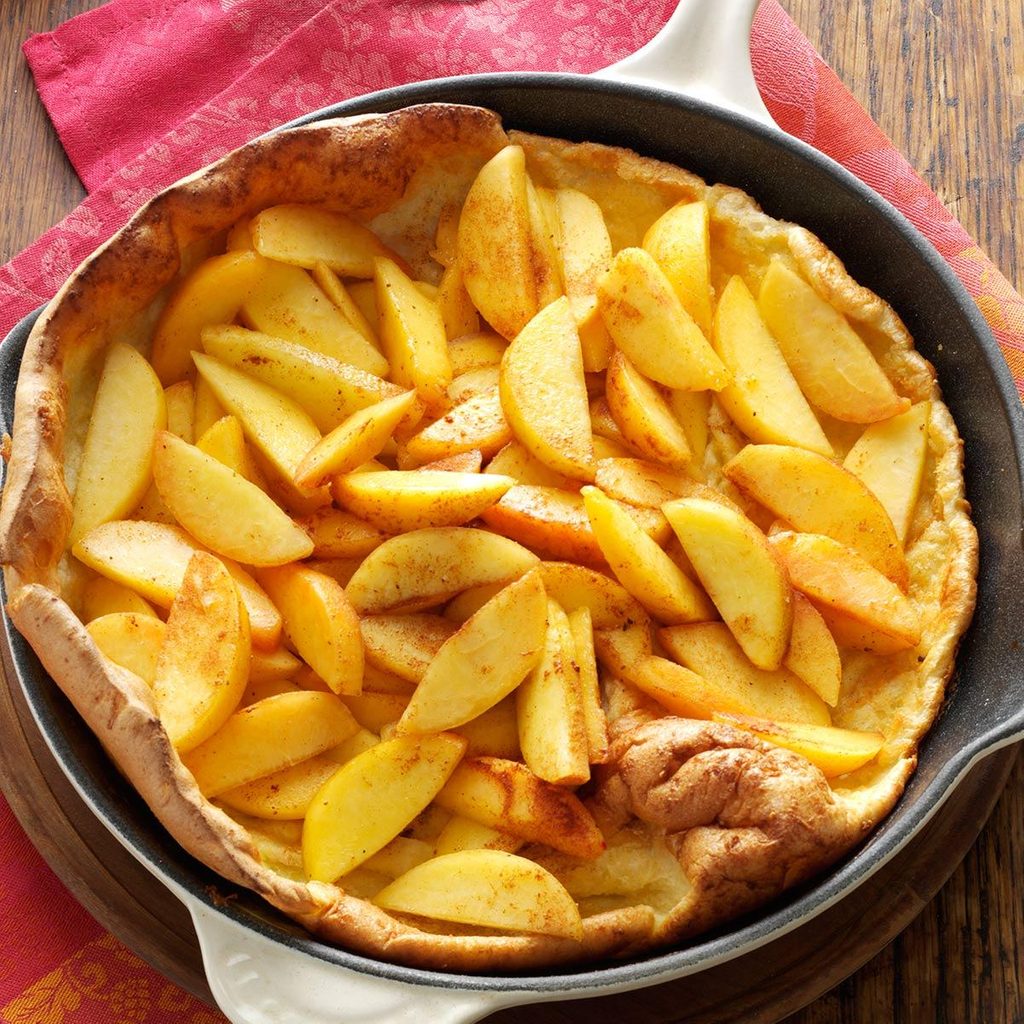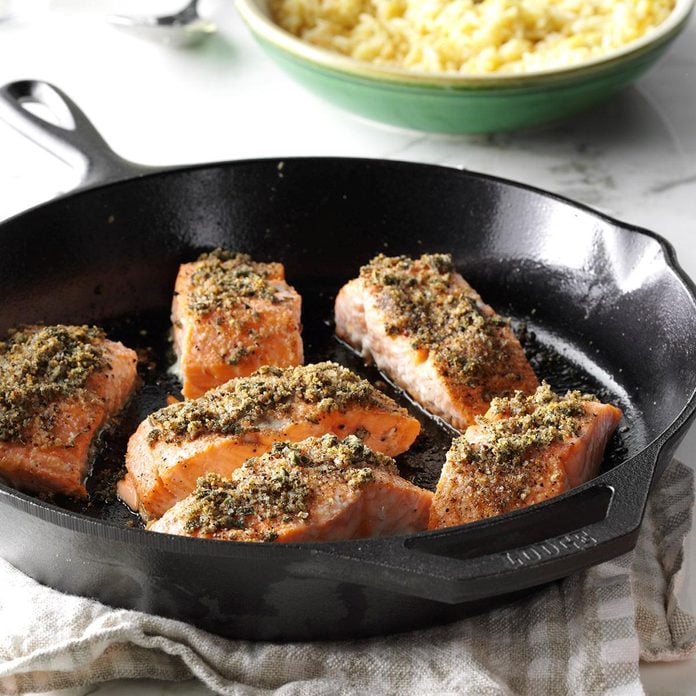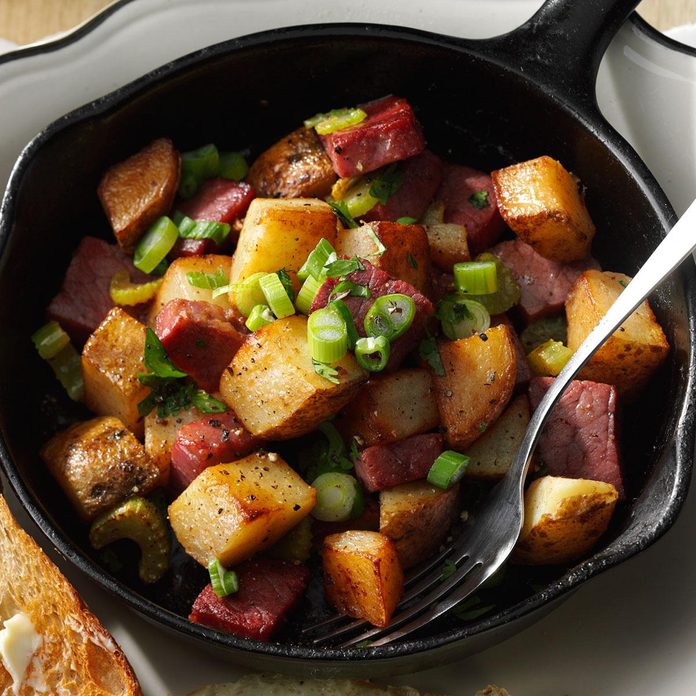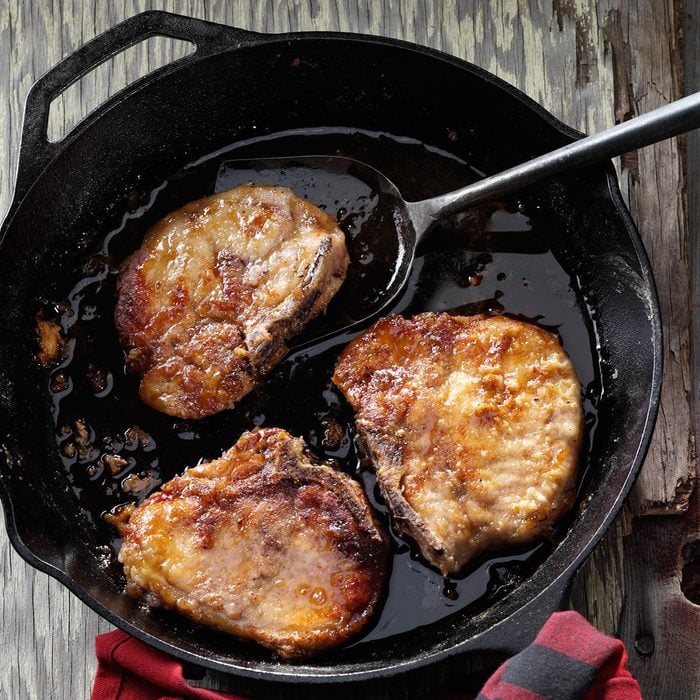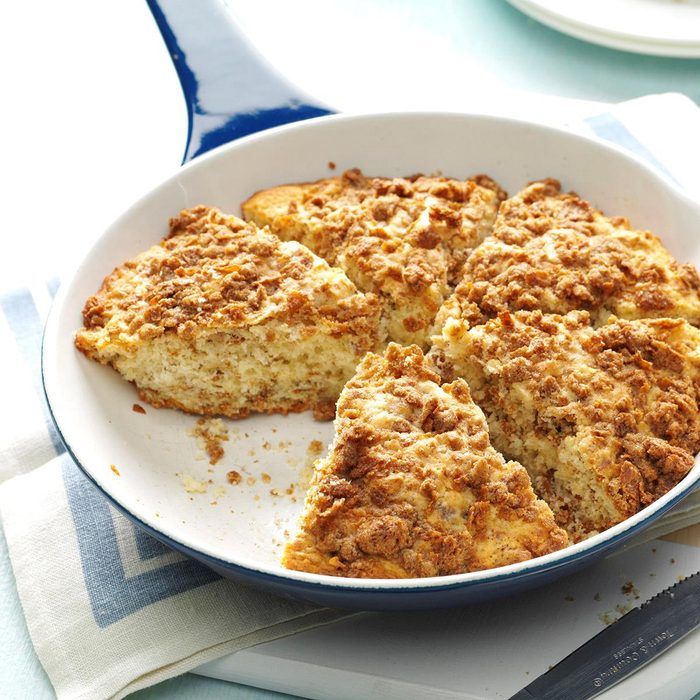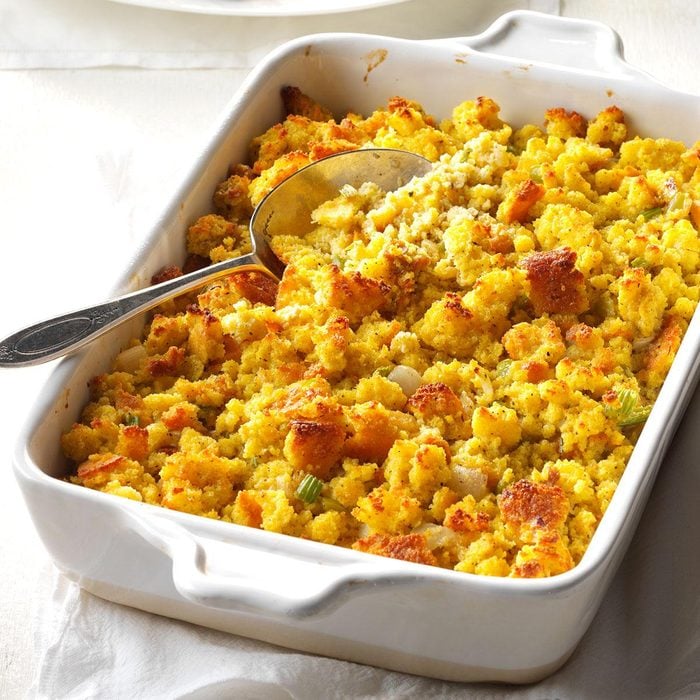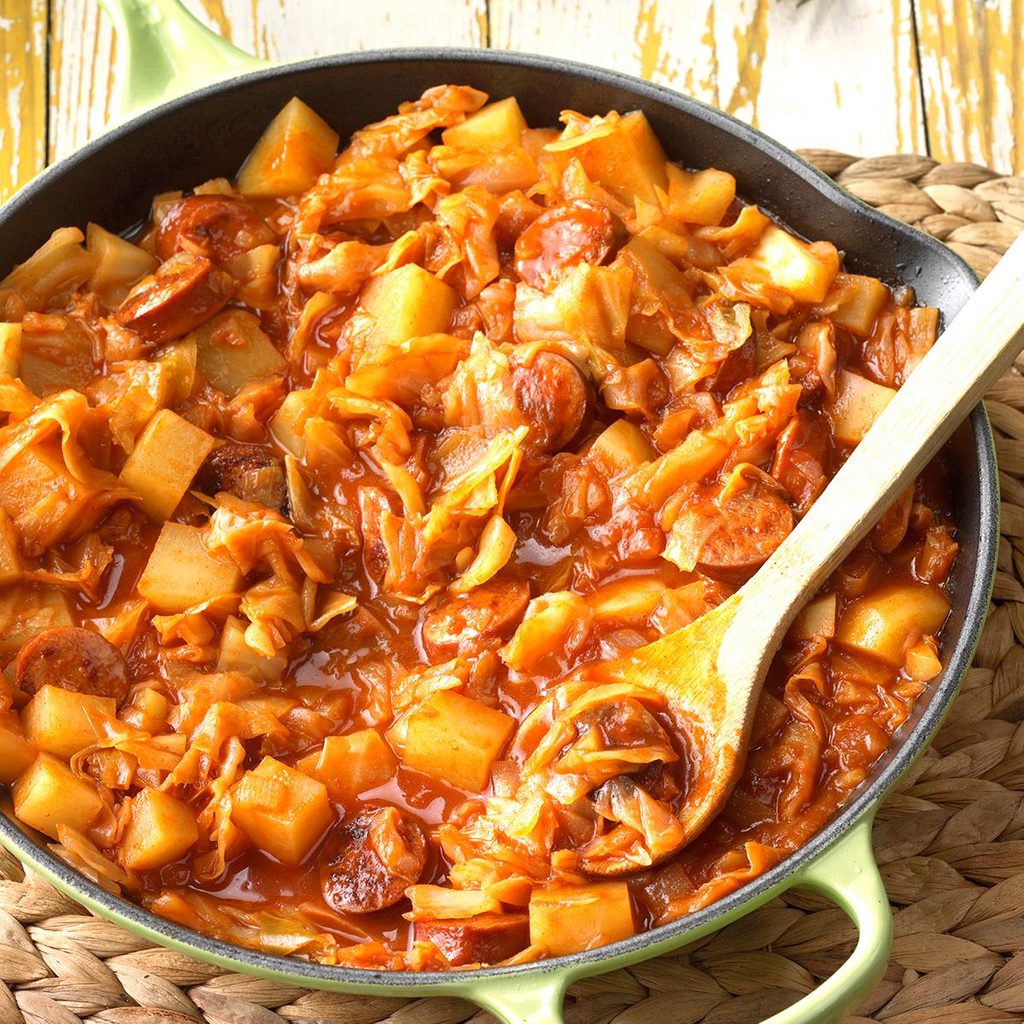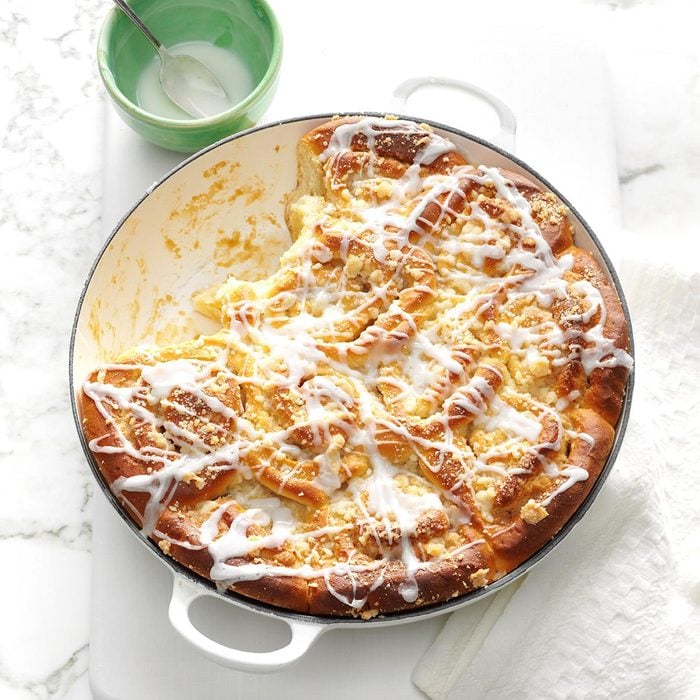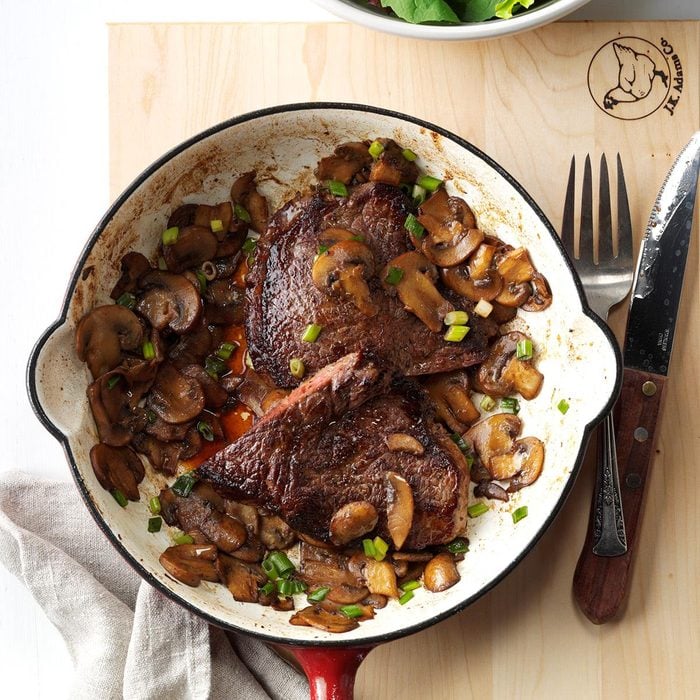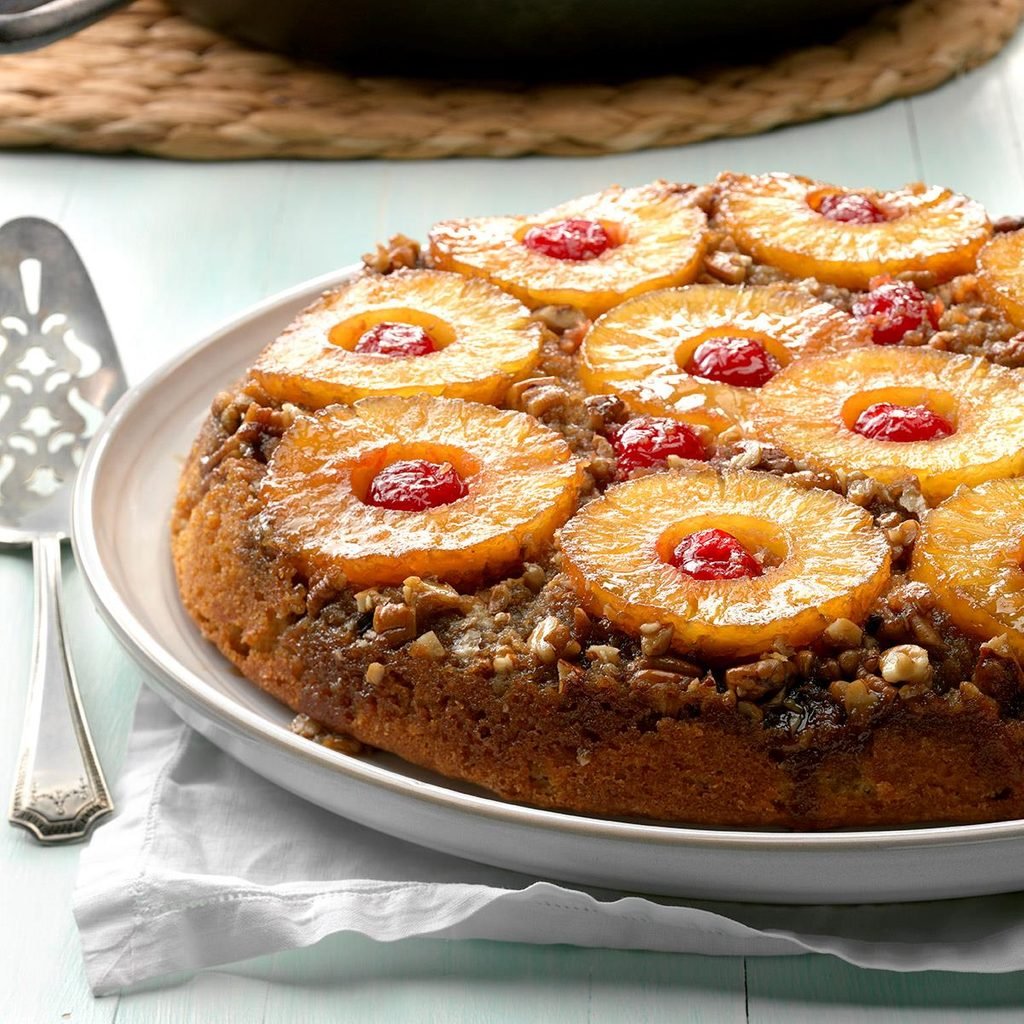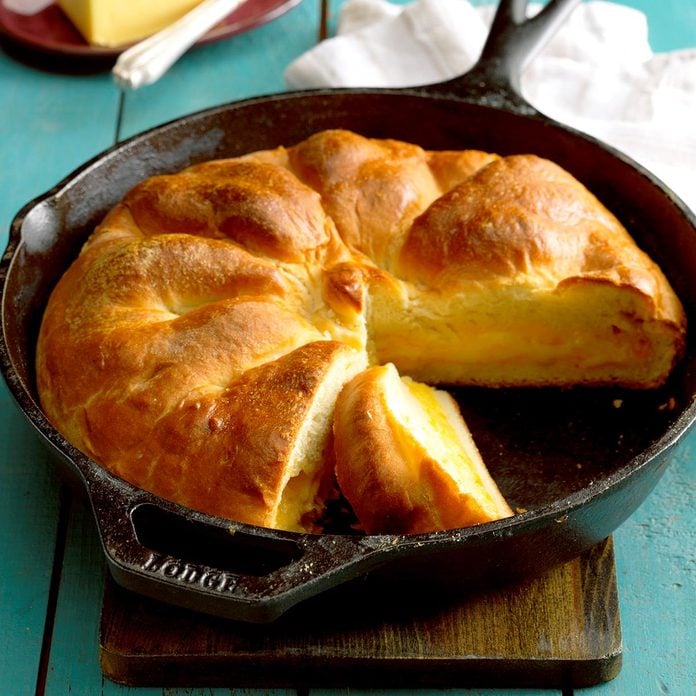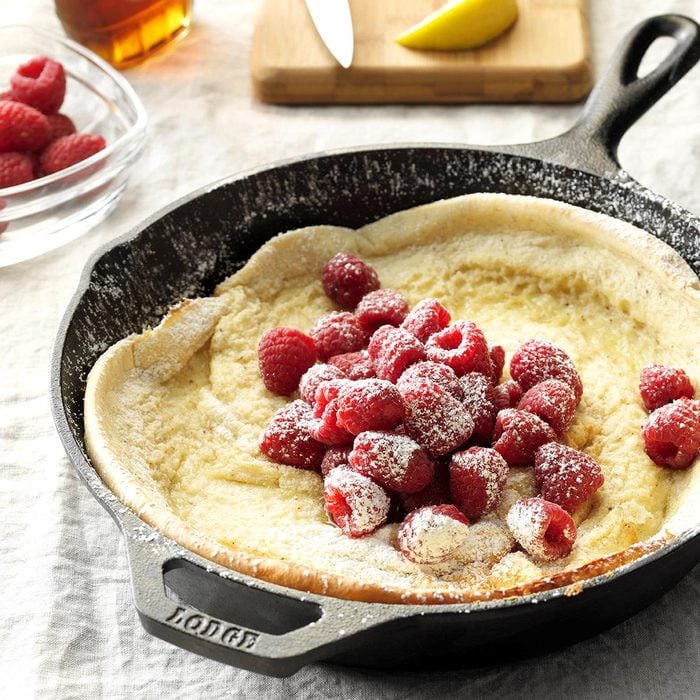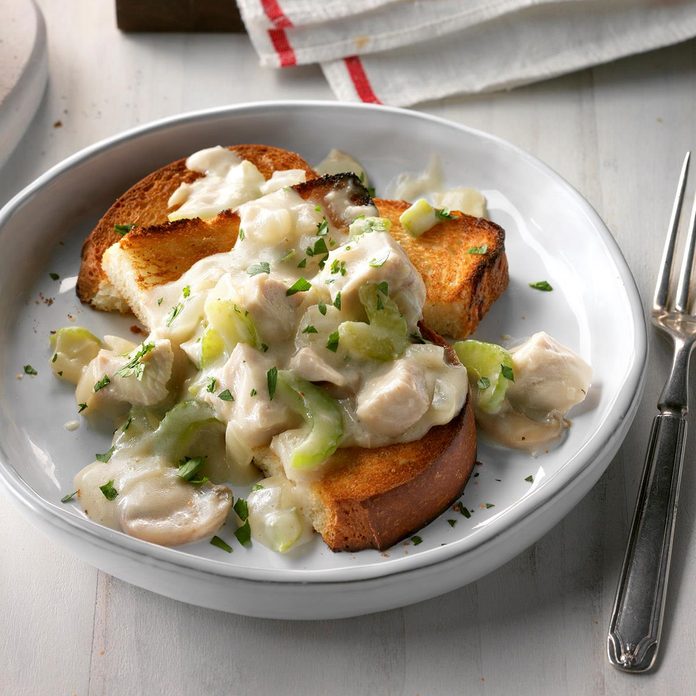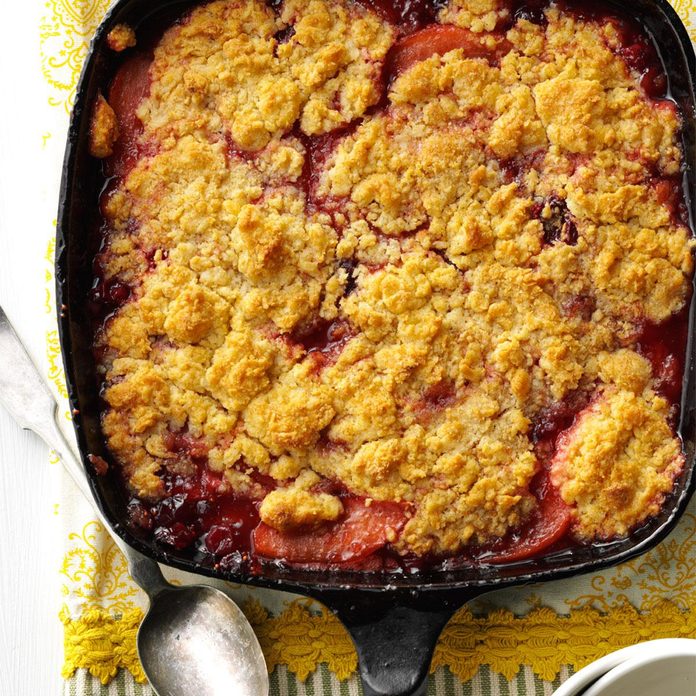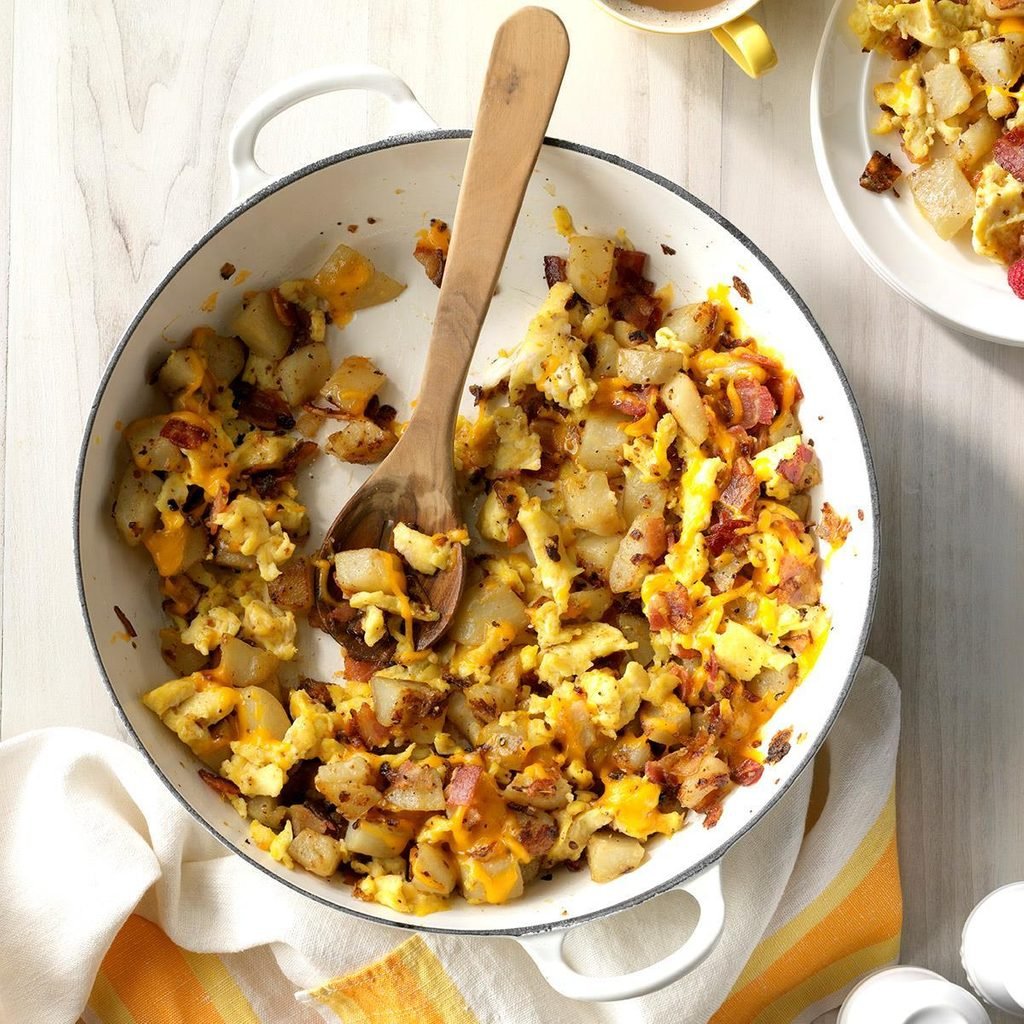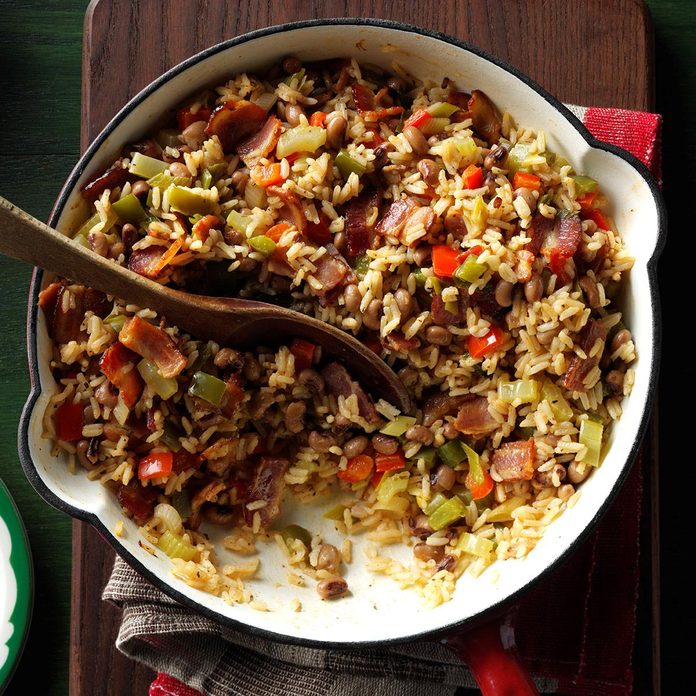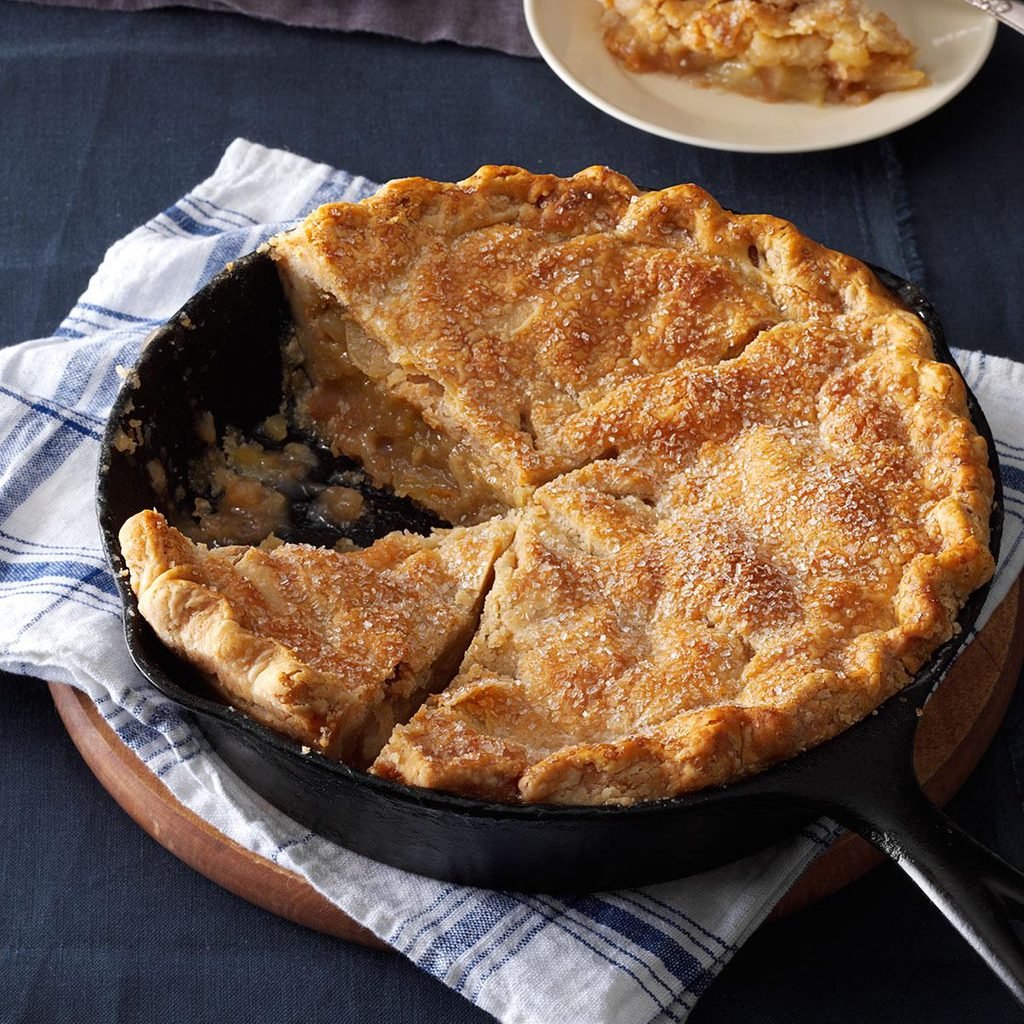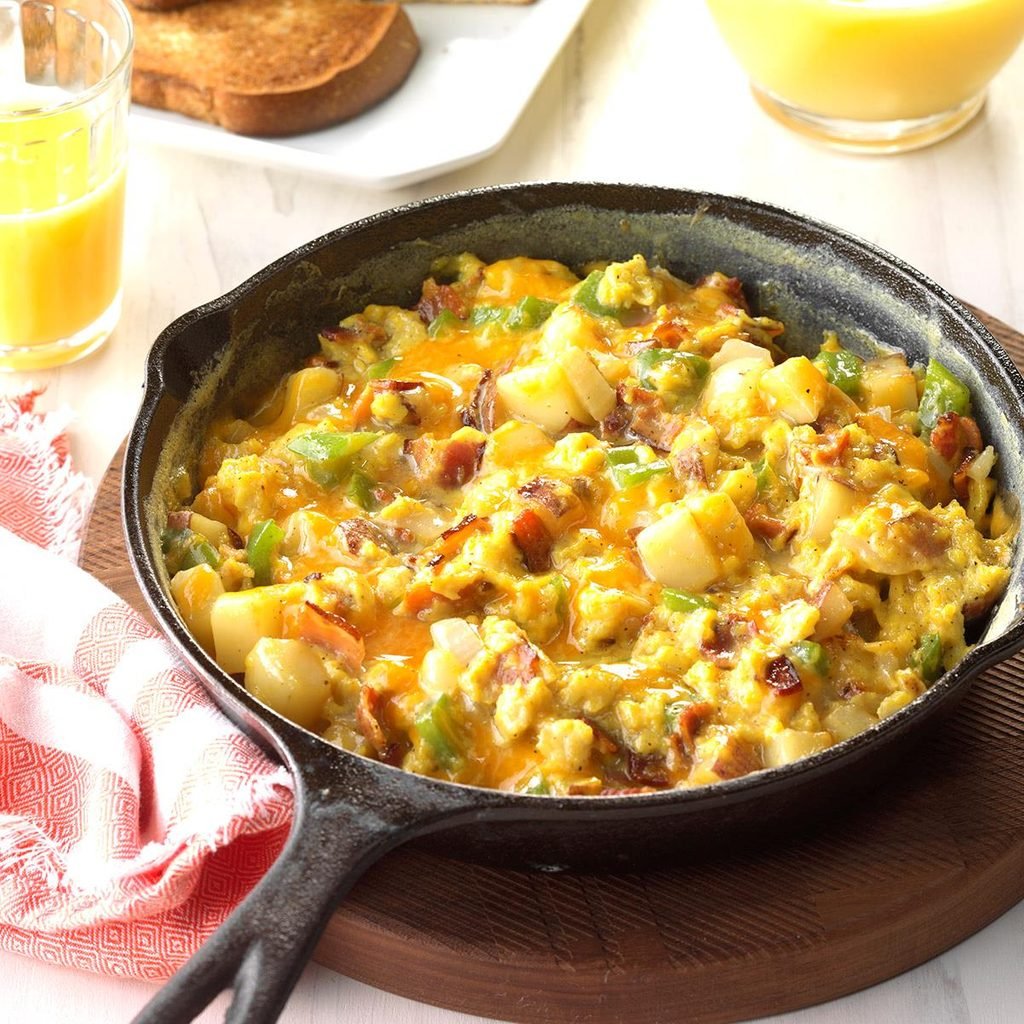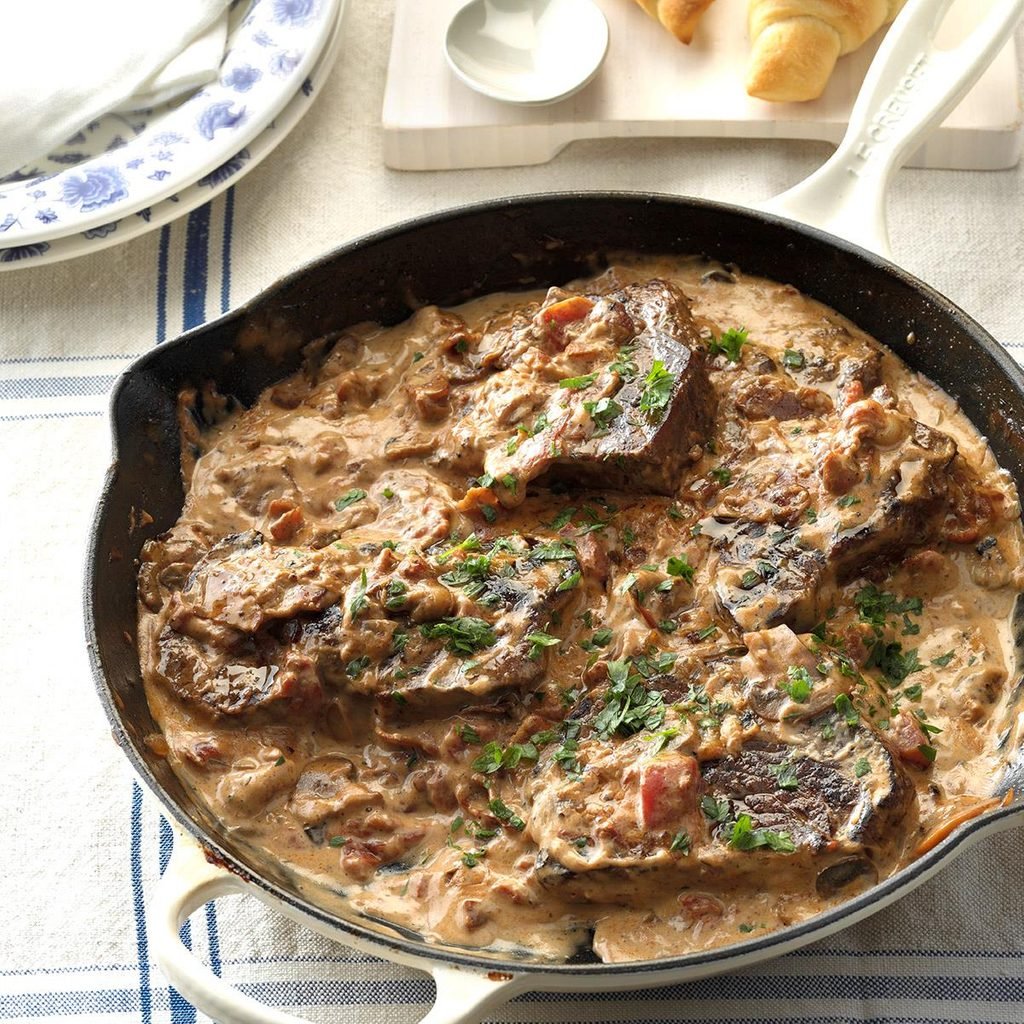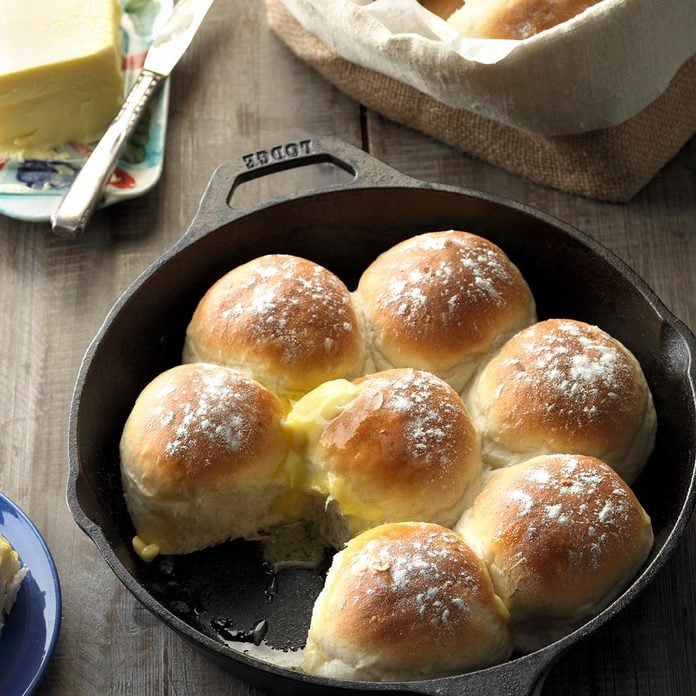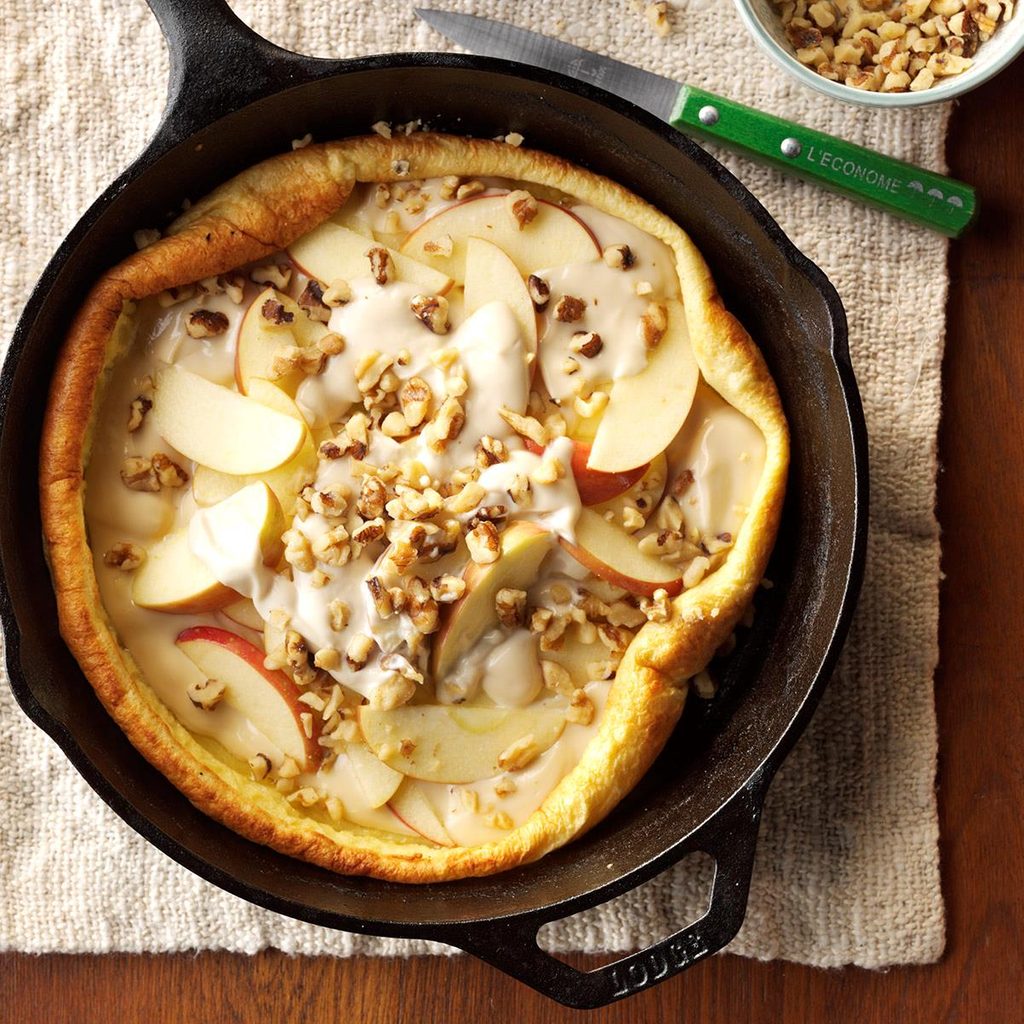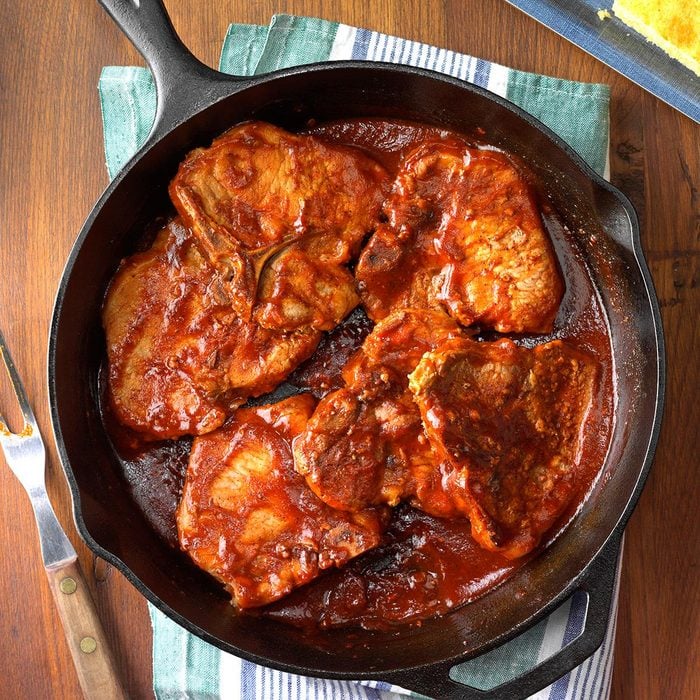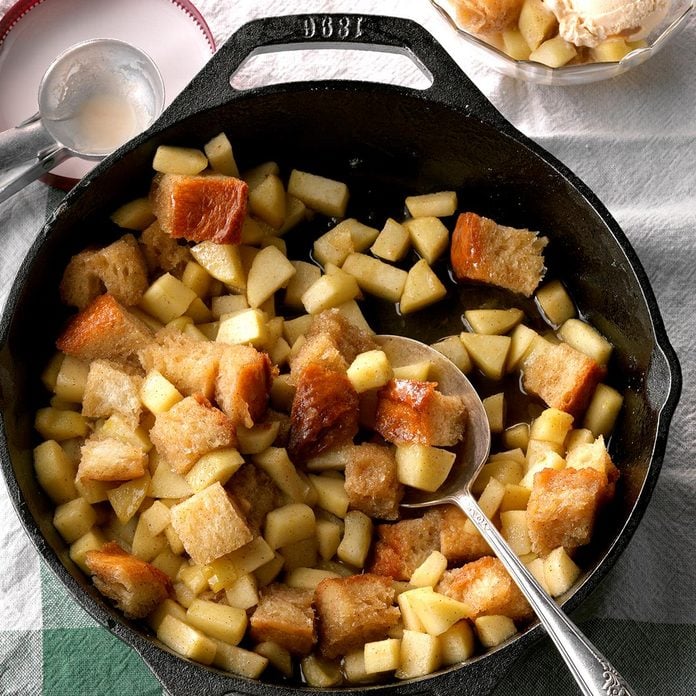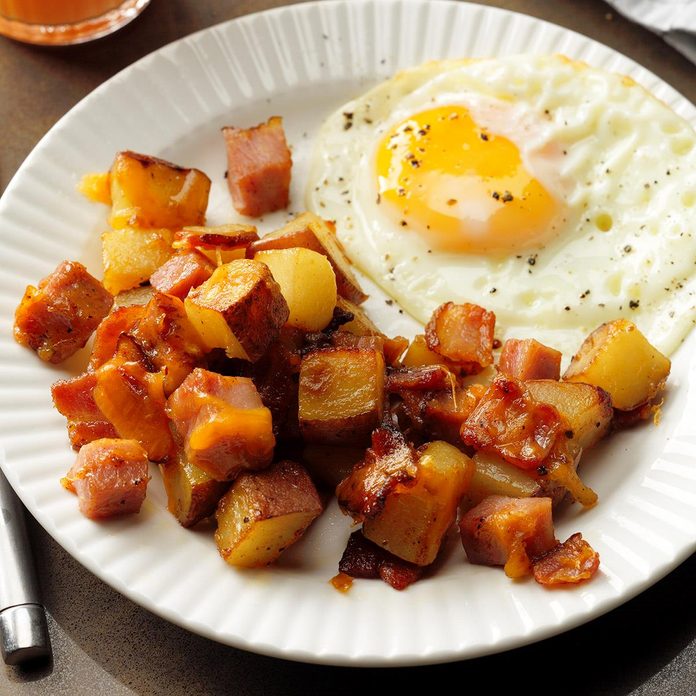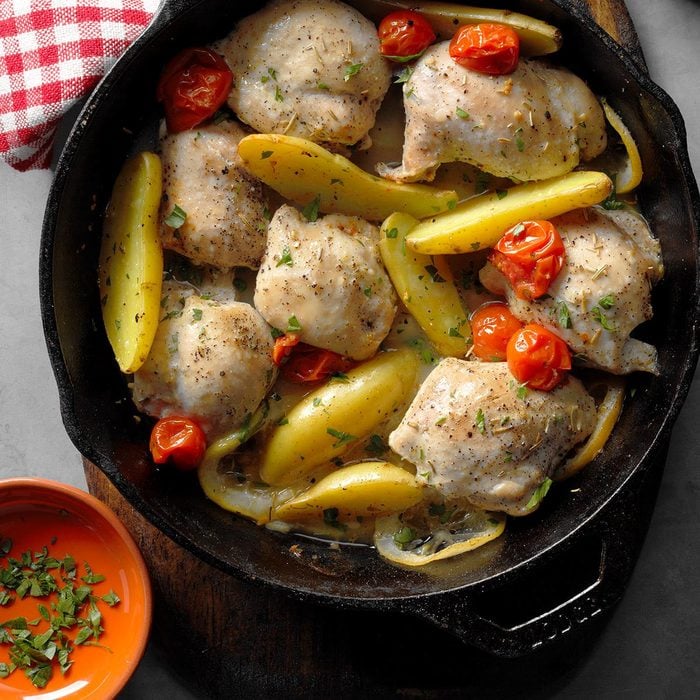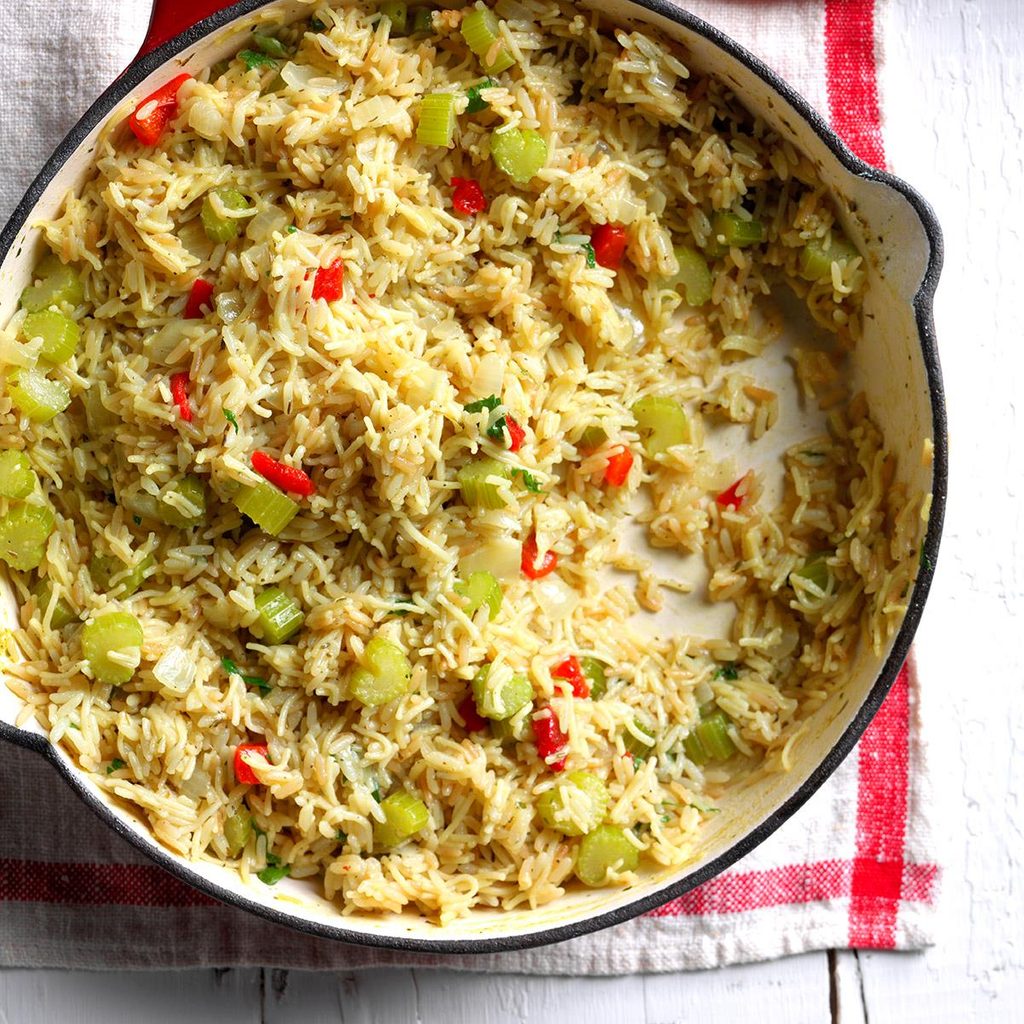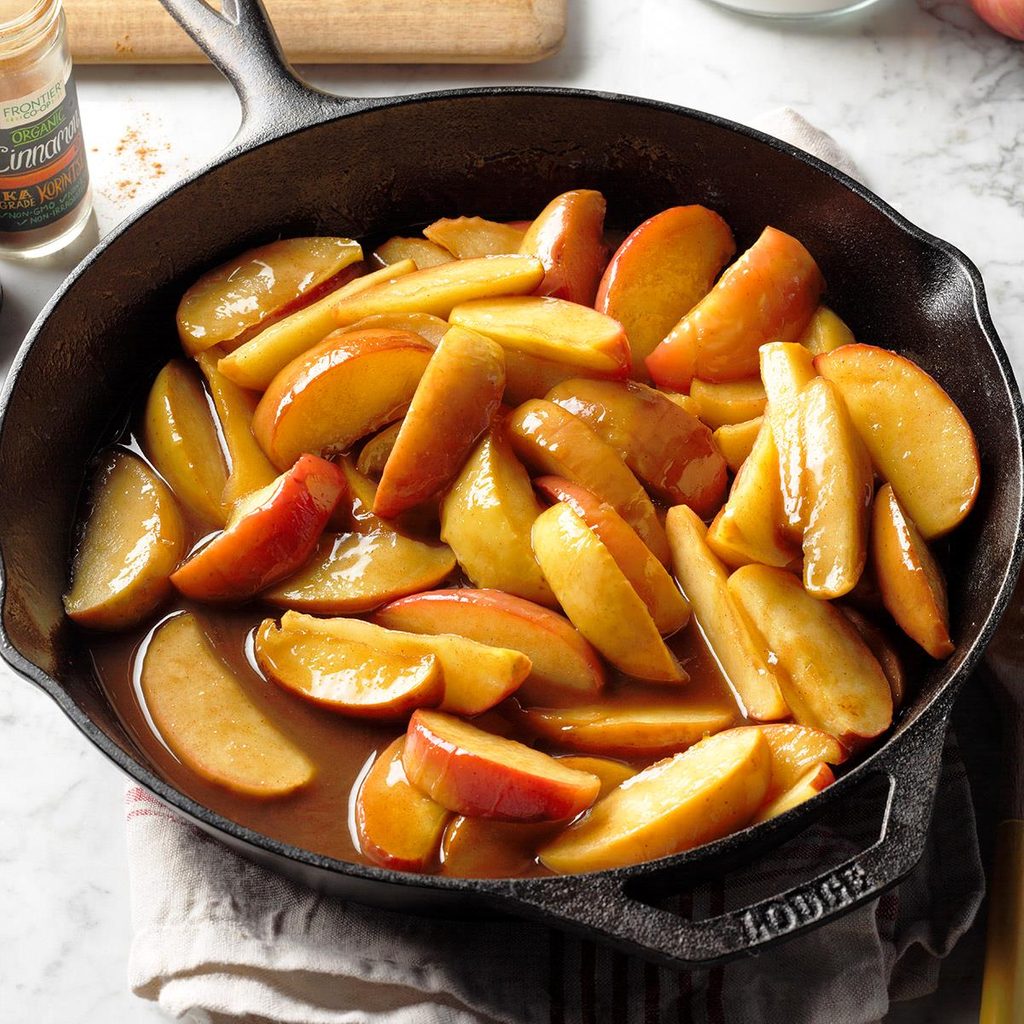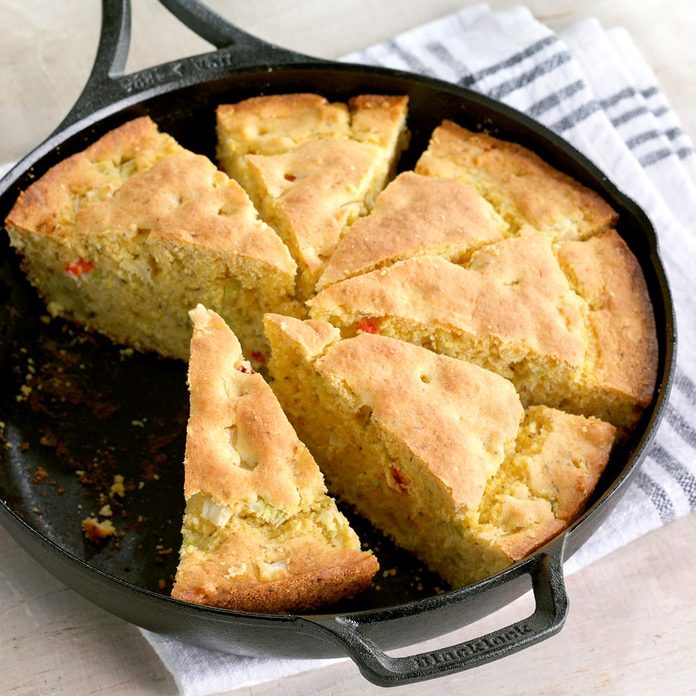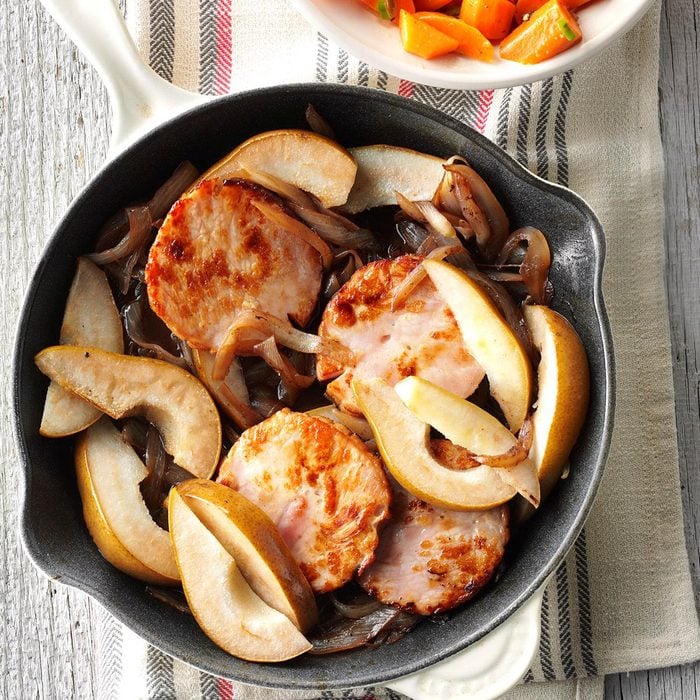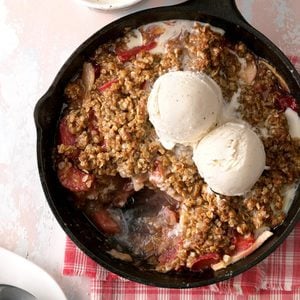 Taste of Home
Taste of Home
I found this strawberry rhubarb crisp recipe on a box of Quaker Oats about 20 years ago. It's quick, and easier to make than pie. It's versatile, too, because you can add strawberries in spring or apples in fall. I usually pop it into the oven shortly before we sit down to eat so it's still warm for dessert! —C.E. Adams, Charlestown, New Hampshire
Get Recipe
One-Skillet Pork Chop SupperMy husband, Clark, and I reserve this recipe for Sundays after the grandkids have gone home and we're too tired to prepare a big meal. It's comforting and quick. —Kathy Thompson, Port Orange, Florida
Cherry-Peach DumplingsYou can make this fruity dessert on your stovetop, but to really impress your guests, simmer it in an electric skillet right at the dinner table. There’s no more convenient way to enjoy the fruits of the season. —Patricia Frerk, Syracuse, New York
Skillet Banana FrittersThis delicious banana treat is sure to be a hit in your home. They are so yummy served with ice cream on the side. For an extra special treat, add chocolate syrup!—Sharon Yonts, Scottsboro, Alabama
Sicilian Brussels SproutsI love to make this dish because the flavors jumping around in your mouth keep you coming back bite after bite. Other nuts can be used in place of the pine nuts. — Marsha Gillett, Yukon, Oklahoma
Apple TartFor 15 years my husband, daughter and I owned and operated an apple orchard, where we raised 27 variations of apples on 2,200 trees. This easy apple tart recipe is my personal favorite. My family even prefers this wonderful dish with tart apples over traditional apple pie. I hope you enjoy it, too. —Marilyn Begres, Dexter, Michigan
Classic Red Beans N RiceAfter living where Cajun cooking is common, we rely on this staple dish. Even If you've never tried red beans and rice, you'll like this recipe! —Jackie Turnage, New Iberia, Louisiana
Au Gratin Peas and PotatoesWhile this delicious potato skillet is a wonderful side dish, we find it satisfying enough to be a main course, too. The skillet preparation takes less time than it does to bake an au gratin casserole or scalloped potatoes—but it's still good old-fashioned comfort food at its best! —Marie Peterson, DeForest, Wisconsin
Skillet RollsBaking these rolls in a skillet makes them soft and tender. My family requests them for most holiday dinners and other special occasions. I like them best split and spread with butter and black raspberry jelly. —Susan Baughman, Houston, Pennsylvania
Homemade ChurrosThese fried cinnamon-sugar homemade churros are best when fresh and hot. Try them with a cup of coffee or hot chocolate. Don't be surprised if people start dunking...and then go back for more.
Farmhouse Pork and Apple PieI've always loved pork and apples together, and this recipe combines them nicely to create a comforting main dish. It calls for a bit of preparation, but my family and I agree the wonderful flavor is well worth the effort. —Suzanne Strocsher, Bothell, Washington
Banana Skillet Upside-Down CakeMy grandmother gave me my first cast iron skillet, and I've been cooking and baking with it ever since. Sometimes I add drained maraschino cherries to this banana skillet dessert and serve it with a ice cream. —Terri Merritts, Nashville, Tennessee
Chocolate Pecan Skillet CookieBake up the ultimate shareable cookie. For variety, swap out the chocolate chips for an equal quantity of M&M's or chocolate chunks. Or go super fancy by mixing the chocolate chips and pecans into the dough, then gently folding in 1-1/2 cups fresh raspberries. —James Schend, Pleasant Prairie, Wisconsin
Chicken Corn FrittersI've always loved corn fritters—this recipe adds chicken and makes them a satisfying main dish. My husband and our three young boys give it rave reviews. The chicken and zesty sauce make the fritters a wonderful brunch or lunch entree. —Marie Greene, Scottsbluff, Nebraska
So Very Berry BrieI needed to make something quick for a wine and cheese party, and had a bounty of berries on hand. My creation went great with all the wines and looked so much more impressive than the other plain cheeses! —Kristin Larson-Jantzi, Newton, Kansas
Grandmother's Toad in a HoleI have fond memories of my grandmother’s Yorkshire pudding wrapped around sausages, a puffy dish my kids called The Boat. Slather it with butter and maple syrup. —Susan Kieboam, Streetsboro, Ohio
Beef and Spinach SkilletOver the years, I've tried to instill a love of cooking in our seven children. And we've enjoyed a variety of delicious recipes, including this one. —Nancy Robaidek, Krakow, Wisconsin
Berry Bliss CobblerA little bit sweet, a little bit tart, topped off with golden, sugar-kissed biscuits, this cobbler is summer perfection. —Taste of Home Test Kitchen, Milwaukee, Wisconsin
Fried Sweet Potato PiesWith my dad being a farmer who grew them, sweet potatoes have graced our table for as long as I can recall. This recipe, however, resulted from an experiment for a church bake sale when we had excess pastry. People couldn't get enough of these pies! —Marilyn Moseley, Toccoa, Georgia
Turkey Biscuit StewThis chunky stew makes a hearty supper, especially in the fall and winter. It's also a great way to use extra turkey during the holidays. —Lori Schlecht, Wimbledon, North Dakota
Milk CakeThis is a simple recipe—and especially easy in a well-seasoned cast-iron skillet. The result is a deliciously light, airy cake. —Suzanne Coelman, Rabun Gap, Georgia
Basil-Butter Steaks with Roasted PotatoesA few ingredients and 30 minutes are all you’ll need for this incredibly satisfying meal. A simple basil butter gives the steaks a very special taste. —Taste of Home Test Kitchen
Country Potato PancakesThese potato pancakes are really versatile. They can be a side dish for just about any meal or the main course for a light meal. Potato pancakes go particularly well with pork. We have them often at our house. —Lydia Robotewskyj, Franklin, Wisconsin
Pinwheel Steak PotpieOn cool nights, nothing hits the spot like a steaming homemade potpie—especially one you can get on the table fast. The pinwheel crust on top has become my signature. —Kristin Shaw, Castleton, New York
Caraway Seed Rye BreadMy parents were immigrants from Czechoslovakia and my mother would pull out this rye bread recipe when guests came over for dinner. Every time I bake it, I get nostalgic for those days. —Millie Feather, Baroda, Michigan
Country Ham and PotatoesBrowned potatoes are a simple but perfect side for country ham. Not only do the potatoes pick up the flavor of the ham, but they look beautiful! Just add veggies or a salad and dinner’s done. —Helen Bridges, Washington, Virginia
Apple-Honey Dutch BabyI love to make this treat on Sunday morning. It's so impressive when it's served warm right out of the oven, and the honey and apple filling is yummy. —Kathy Fleming, Lisle, Illinois
Brunch Hash & Egg BakeWhen my kids were growing up, I was cooking for eight. I couldn't conveniently fry eggs for that many people, so I devised this recipe that became a family favorite. Mild and salty feta cheese is my favorite for the dish, but shredded cheddar or Parmesan work, too. —Lily Julow, Lawrenceville, Georgia
Seasoned Crab CakesAt the National Hard Crab Derby in Crisfield, Maryland, these scrumptious crab cakes won me first place. I entered them on a whim after trying many crab cake recipes for my family. —Betsy Hedeman, Timonium, Maryland
Skillet Blueberry SlumpMy mother-in-law made a slump of wild blueberries with dumplings and served it warm with a pitcher of farm cream. We’ve been enjoying slump desserts for 60 years. —Eleanore Ebeling, Brewster, Minnesota
Caramel-Apple Skillet BuckleMy grandma used to bake a version of this for me when I was a little girl. She would make it using fresh apples from her tree in the backyard. I've adapted her recipe because I love the combination of apples, pecans and caramel. —Emily Hobbs, Springfield, Missouri
Skillet Zucchini and SausageI lived on the Oregon coast for 20 years and had plenty of guests dropping by. I often turned to this quick and easy dish, serving it up with skillet cornbread or garlic bread. Judging by the requests for the recipe, everyone loved it! —LaBelle Doster, Vancouver, Washington
Macaroon-Topped Rhubarb CobblerCrumbled macaroons are a surprising addition to this cobbler’s topping. We love that you can make the sweet treat in a baking dish or a cast-iron skillet.
—Taste of Home Test Kitchen
Grandma Pruit's Vinegar PieThis historic pie has been in our family for many generations and is always served at our get-togethers.—Suzette Pruit, Houston, Texas
Homey Mac & CheeseI also call this "my grandson's mac and cheese." Zachary has been to Iraq and Afghanistan with both the Marines and Navy, and I've been privileged to make his favorite casserole for him for over 20 years. —Alice Beardsell, Osprey, Florida
Pork Chops with Tomato-Bacon ToppingMy husband and I collaborated on these pork chops with sun-dried tomatoes, bacon and rosemary. They’re easy enough for any day and fancy enough for special events. —Trisha Klempel, Sidney, Montana
Country CorncakesAlthough we live in a suburban area, we are lucky to have plenty of farms nearby where we can purchase fresh corn. But, when it's out of season, I substitute canned or frozen corn in this favorite recipe. —Anne Frederick, New Hartford, New York
Meatball Chili with DumplingsMy family enjoys this delicious recipe—it's like a spicy meatball stew with dumplings!—Sarah Yoder, Middlebury, Indiana
Plum Upside-Down CakeSince my husband liked pineapple upside-down cake, I decided to give this recipe a try one night when we were expecting guests for dinner. Everyone pronounced this cake "Delicious!" and asked for seconds.—Bobbie Talbott, Veneta, Oregon
Skillet Chicken Cordon BleuA dear friend from my high school days shared this recipe with me. You might think it sounds complicated to make, but it's quite easy once you've tried it. —Nancy Zimmerer, Medina, Ohio
Baked Peach PancakeThis dish makes for a dramatic presentation. I usually take it right from the oven to the table, fill it with peaches and sour cream and serve it with bacon or ham. Whenever I go home, my mom (the best cook I know) asks me to make this. —Nancy Wilkinson, Princeton, New Jersey
Sage-Rubbed SalmonIf you’ve always thought of sage with turkey, try it with salmon for a little taste of heaven. We serve this with rice, salad and sauteed green beans. —Nicole Raskopf, Beacon, New York
Diner Corned Beef HashI created my hash to taste like a dish from a northern Arizona restaurant we always loved. We round it out with eggs and toast made from homemade bread. —Denise Chelpka, Phoenix, Arizona
Cherry-Peach DumplingsYou can make this fruity dessert on your stovetop, but to really impress your guests, simmer it in an electric skillet right at the dinner table. There’s no more convenient way to enjoy the fruits of the season. —Patricia Frerk, Syracuse, New York
Maple-Glazed Pork ChopsEveryone cleaned their plates when my mother made these succulent, tangy-sweet pork chops when I was growing up. Now I get the same results when I serve them to my family alongside applesauce and au gratin potatoes. —Cheryl Miller, Fort Collins, Colorado
Kate Smith Coffee CakeWhen I lived in an orphanage more than 50 years ago, I helped out in the kitchen, often making this wonderful coffee cake and dutifully following the recipe the cooks used. Years later, seeing Kate Smith on television, I realized that I had been making one of the singer's own favorite recipes from her cookbook! —Ruth Nast, Waterford, Connecticut
Grandma's Cornbread DressingGrowing up, we didn’t have turkey. We had chicken, chopped and baked in my grandmother’s dressing. Now we leave out the chicken and keep the cornbread dressing. —Suzanne Mohme, Bastrop, Texas
Kielbasa Cabbage SkilletSpicy kielbasa sausage and plentiful cabbage and potatoes give this dish a pleasing Old World flair. My husband never liked cabbage before I made this, but now he does! —Romaine Wetzel, Ronks, Pennsylvania
Almond Streusel RollsTry my prizewinning pastry! These rolls are so popular that they often don't even cool completely before the pan is empty. —Perlene Hoekema, Lynden, Washington
Skillet Steak SupperWith all the ingredients cooked in one skillet, this steak dish couldn't be quicker to prepare—or to clean up! But the wine and mushroom sauce makes it seem special. —Sandra Fisher, Missoula, Montana
Spiced Pineapple Upside-Down CakeI often bake this beautiful cake in my large cast-iron skillet and turn it out
onto a pizza pan. —Jennifer Sergesketter, Newburgh, Indiana
Muenster BreadMany years ago my sister and I won blue ribbons in 4-H with this bread. The recipe makes a beautiful golden loaf with cheese peeking out of every slice. —Melanie Mero, Ida, Michigan
Old-World Puff PancakeMy mom told me her mother-in-law showed her how to make this dish, which became popular during the Depression, on their "get acquainted" visit in 1927. At that time, cooks measured ingredients in pinches, dashes and dibs. But through the years, accurate amounts were noted. My wife and I continue to enjoy this dish today, particularly for brunch. —Auton Miller, Piney Flats, Tennessee
Turkey a La KingThis is a smart way to use up leftover turkey. You might want to make a double batch! —Mary Gaylord, Balsam Lake, Wisconsin
Cran-Apple CobblerMy cranberry-packed cobbler is the crowning glory of many of our late fall and winter meals. My family isn't big on pies, so this favorite is preferred at our Thanksgiving and Christmas celebrations. The aroma of cinnamon and fruit is irresistible. —Jo Ann Sheehan, Ruther Glen, Virginia
Farmers BreakfastStart off your day on a hearty note. This one-dish wonder will easily keep your busy family satisfied until lunch. —Jeannette Westphal, Gettysburg, South Dakota
Upside-Down Apple Cake with Butterscotch ToppingThis cake is a favorite of mine. I love the smell of the apples and butterscotch as it is baking. It fills the house with a perfect autumn aroma. —Sabrina Haught, Spencer, West Virginia
Southern Hoppin' JohnThis cherished Southern dish of peas and rice is served on New Year’s Day for good luck and prosperity. Make it an annual tradition for your family, too. —Anne Creech, Kinston, North Carolina
Cinnamon-Sugar Apple PieCinnamon apple pie baked in a cast iron skillet is a real stunner. This beauty, with its flaky, tender crust, also works in a 9-inch deep-dish pie plate. —Renee Schettler Rossi, New York, New York
Country-Style Scrambled EggsI added a little color and flavor to this country scrambled eggs recipe by adding some green pepper, onion and red potatoes. —Joyce Platfoot, Wapakoneta, Ohio
Oven Swiss SteakI was really glad to find this recipe since it's a great way to use round steak and it picks up fabulous flavor from one of my favorite herbs—tarragon. I am a homemaker with three children and enjoy cooking tasty dinners like this one for my family.
—Lorna Dickau, Vanderhoof, British Columbia
Potato Pan RollsMy family loves these rolls and requests them often. They don't take long to make because you use quick-rise yeast. —Connie Storckman, Evanston, Wyoming
Chicken Cheese StrataThe spices in this simple strata with chicken, broccoli and cheese offer an extra special taste. —Taste of Home Test Kitchen
Apples 'n' Cream PancakeThis cozy recipe is delicious for breakfast or brunch. I usually make a double batch because everyone wants more! With our own orchard, we have plenty of Delicious and Winesap apples—they make this a true midwestern meal. —Ruth Schafer, Defiance, Ohio
Oven-Barbecued Pork ChopsMy mother has fixed this recipe for years and now I prepare it for my family. The chops are delicious with scalloped potatoes and home-baked bread. —Teresa King, Whittier, California
Cinnamon Apple Pan BettyI found this recipe soon after I was married decades ago. You'll need just a few ingredients that you probably have on hand. It's super quick to put together and a favorite of ours during fall and winter, when apples are at their best. —Shirley Leister, West Chester, Pennsylvania
Loaded Breakfast PotatoesMy kids love loaded potatoes in restaurants, so I modified them to make at home. Using the microwave for the potatoes will save you about 10 minutes. I also use thin-skinned red potatoes instead of russets to save on peeling time. —Tena Kropp, Aurora, Illinois
Skillet-Roasted Lemon Chicken with PotatoesThis is a meal I have my students make in our nutrition unit. It has a delicious lemon-herb flavor and is simple to make. —Mindy Rottmund, Lancaster, Pennsylvania
Herbed Rice PilafThis savory side dish has been a family favorite for years. Our 12-year-old daughter, Jennifer, is an expert with this recipe, which is a great help for a busy working mom like me. We sure enjoy this rice dish in the summer with a grilled entree. —Jeri Dobrowski, Beach, North Dakota
Mom's Fried ApplesMom often made these rich, cinnamon-sugar apples when I was growing up. It's a trip down memory lane when I make them. The recipe is very dear to me. —Margie Tappe, Prague, Oklahoma
Skillet Herb BreadWe had a lot of family get-togethers while I was growing up. My grandmother, aunts and mom were all good cooks, and each had her own specialty when it came to bread. Mom's was my favorite—she created this recipe more than 40 years ago. The flavors call to mind the taste of cornbread stuffing! —Shirley Smith, Yorba Linda, California
Glazed Smoked Chops with PearsMy husband would eat pork chops every day if he could. Luckily, they're good prepared in all sorts of ways, including with pears. —Lynn Moretti, Oconomowoc, Wisconsin
Up Next: If You See
Black Residue on Your Cast-Iron Skillet, This Is What It Means
